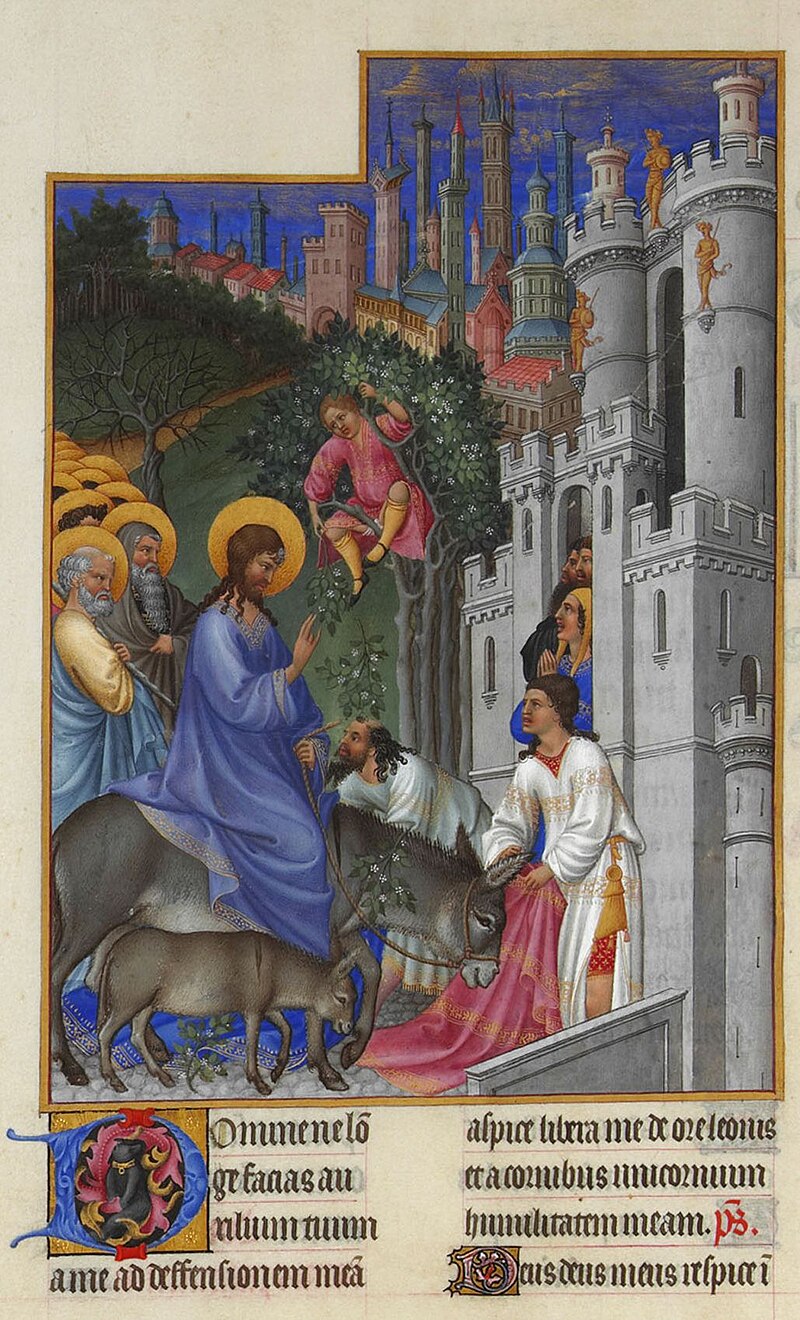
聖週間
Semana Santa
☆ 受難週(じゅなんしゅう:プロテスタント)、聖週間(せいしゅうかん:カトリッ ク)、聖週(せいしゅう:聖公会)、受難週間(じゅなんしゅうかん:正教会)、(英: Passion Week, Holy Week, 西: Semana Santa)とは、棕櫚の主日(=枝の主日、聖枝祭)から、復活祭(=復活大祭)の前日までの一週間を指す。イエス・キリストがエルサレムで受けた苦難を 記憶する事から「受難週」等の名がある。 この週の木曜日は「聖木曜日」(「洗足木曜日」、「聖大木曜日」)、金曜日は「聖金曜日」(「受難日」、「受苦日」、「聖大金曜日」とも)、土曜日は「聖 土曜日」と呼ばれる。キリストの受難については、使徒言行録で「神は、すべての預言者たちの口を通して、キリストの受難をあらかじめ語っておられたこと を、このように実現されました」(3:18)と明言されている。よって、受難は使徒の教えの中心をなしていたといえよう。だが、弟子たちは苦難の意味を復 活までは、本当の意味では理解してはいなかった(マタイ16:21‐28など多数)。従って、イエスのエルサレム入城を始点としたこの1週間も、さほど重 要視していなかったであろう。受難週の各曜日における出来事を福音書の記述に従って行う伝統は、エルサレム教会で2-3世紀頃から行われていたようであ る。今日でも正教会、カトリック教会、聖公会では各曜日に様々な行事が行われている。ただ、プロテスタントでは教派や国によって採用する行事にばらつきが ある(→「聖週間」)。
| La Semana Santa[a]
es la conmemoración cristiana anual de la pasión de Cristo, es decir,
de la entrada a Jerusalén, la última cena, el viacrucis, la muerte y
resurrección de Jesús de Nazaret. Comienza el Domingo de Ramos y
finaliza el Domingo de Resurrección.[2] Aunque su celebración suele
iniciarse en varios lugares el viernes anterior, es decir, el Viernes
de Dolores. La fecha de la celebración es variable: entre mediados de
marzo y abril. Sigue siendo Cuaresma hasta el atardecer del Jueves Santo, cuando da comienzo el Triduo Pascual: ese mismo día se celebra la institución de la Eucaristía en la última cena; el Viernes Santo, la crucifixión y muerte del Señor, y la noche del Sábado Santo, la Vigilia Pascual. Durante la Semana Santa tienen lugar numerosas muestras de religiosidad popular a lo largo de todo el mundo destacando las procesiones, penitencias y las representaciones de la Pasión, muerte y resurrección de Jesús.[3] En algunos países se ha tomado como días de asueto, lo que también le ha valido la denominación de Semana De Dios. |
聖週間[a]は、キリストの受難、すなわちエルサレム入城、最後の晩
餐、十字架の駅、ナザレのイエスの死と復活を記念するキリスト教の年中行事である。パーム・サンデーに始まりイースター・サンデーに終わるが[2]、いく
つかの地域ではその前の金曜日、すなわち悲しみの金曜日から祝うのが一般的である。祝日の日付は3月中旬から4月まで様々である。 この日、最後の晩餐における聖体の授与が祝われ、聖金曜日には主の磔刑と死が祝われ、聖土曜日の夜には復活徹夜祭が行われる。聖週間には、行列、苦行、イ エスの受難と死と復活の表現など、民衆の宗教性を示す数多くの催しが世界中で行われる[3]。いくつかの国では、聖週間は聖体の日とされてきた。 また、休息日としている国もあり、そのためセマナ・デ・ディオス(神の週)と呼ばれることもある。 |
| Ritual de Semana Santa Es un libro litúrgico donde aparece toda la liturgia de la Semana Santa como es: Domingo de Ramos, Lunes, Martes y Miércoles Santo; y donde aparece el triduo pascual que comienza el Jueves Santo con la Santa Cena del Señor. Continúa con el Viernes Santo donde se celebra la pasión y muerte del Señor, el Sábado de Gloria que es el último día de este triduo pascual y el domingo de resurrección para celebrar que Jesús ha resucitado. Es un libro católico sacerdotal que tiene lecturas y oraciones propios de la Semana Santa. |
聖週間儀式 これは、棕櫚の主日、聖月曜日、聖火曜日、聖水曜日といった聖週間の典礼のすべてと、主の晩餐が行われる洗足木曜日から始まる復活の三日間を収めた典礼書 である。主の受難と死を記念する聖金曜日、この復活祭の三日間最後の日である聖土曜日、そしてイエスが復活したことを祝う復活祭の日曜日へと続く。 これは、聖週間の朗読と祈りを収めたカトリックの聖職者向けの書物である。 |
| Triduo pascual Los días más importantes de la Semana Santa son los correspondientes al Triduo Pascual, que conmemoran la pasión, muerte y resurrección del Señor en Jerusalén . En la liturgia romana de la Iglesia católica, comprende desde la tarde del Jueves Santo —cuando concluye la Cuaresma— hasta el Domingo de Resurrección.[4] |
復活祭三連祭 聖週間で最も重要な日は、エルサレムにおける主の受難、死、復活を記念する復活祭三連祭である。ローマ・カトリック教会の典礼では、四旬節が終わる「聖木 曜日」の夕方から復活祭の日曜日まで行われる[4]。 |
| La fecha de la Semana Santa Artículo principal: Cálculo de la fecha de Pascua Es en el Concilio de Nicea I, en el año 325, donde se llega finalmente a una solución para este asunto. En él se estableció que la Pascua de Resurrección había de ser celebrada cumpliendo unas normas: Que la Pascua se celebrase en un domingo. Que no coincidiese nunca con la Pascua judía, que se realizaba independientemente del día de la semana (de esta manera se evitarían paralelismos o confusiones entre ambas religiones). Que los cristianos no celebrasen nunca la Pascua dos veces en el mismo año. Esto tiene su explicación, porque el año nuevo empezaba con el equinoccio de primavera, por lo que se prohibía la celebración de la Pascua antes del equinoccio real (antes de la entrada del sol en Aries). No obstante, siguió habiendo diferencias entre la Iglesia de Roma y la Iglesia de Alejandría, si bien el Concilio de Nicea dio la razón a los alejandrinos, estableciéndose la costumbre de que la fecha de la Pascua se calculaba en Alejandría, que lo comunicaba a Roma, la cual difundía el cálculo al resto del cristianismo. Finalmente, Dionisio el Exiguo (en el año 525), desde Roma convenció de las bondades del cálculo alejandrino, unificándose al fin el cálculo de la Pascua cristiana. La Pascua de Resurrección es el domingo inmediatamente posterior a la primera luna llena tras el equinoccio de marzo, y se debe calcular empleando la luna llena astronómica. Por ello puede ocurrir no antes del 22 de marzo y el 25 de abril como máximo.[5][6] |
イースターの日付 主な記事:復活祭の日付の計算 この問題が最終的に解決されたのは、325年のニカイア公会議においてであった。復活祭は一定の規則に従って祝うことが決定されたのである: 復活祭は日曜日に行う。 イースターは日曜日に祝われるべきで、ユダヤ教の過越祭とは決して重なってはならない。 キリスト教では、同じ年に2度イースターを祝ってはならない。これは、新年が春分とともに始まるという事実によって説明することができ、実際の春分前(牡 羊座の太陽が昇る前)にイースターを祝うことは禁じられていた。 しかし、ローマ教会とアレキサンドリア教会との間には意見の相違が続いていた。ニカイア公会議がアレキサンドリア教会に権利を与え、イースターの日付はア レキサンドリアで計算されるという習慣が確立され、アレキサンドリアはそれをローマに伝え、ローマはその計算をキリスト教全体に広めた。 そして525年、ローマ出身のディオニシウスがアレクサンドリアの計算の正当性を認め、ついにキリスト教の復活祭の計算が統一された。 イースターは3月分後の最初の満月の直後の日曜日であり、天文学的な満月を用いて計算されなければならない。そのため、3月22日よりも早く、4月25日 よりも早くは起こりえない[5][6][7][8][9]。 |
| Días de la Semana Santa Estos son todos los días de Semana Santa: |
聖週間の日 これらは聖週間のすべての日である: |
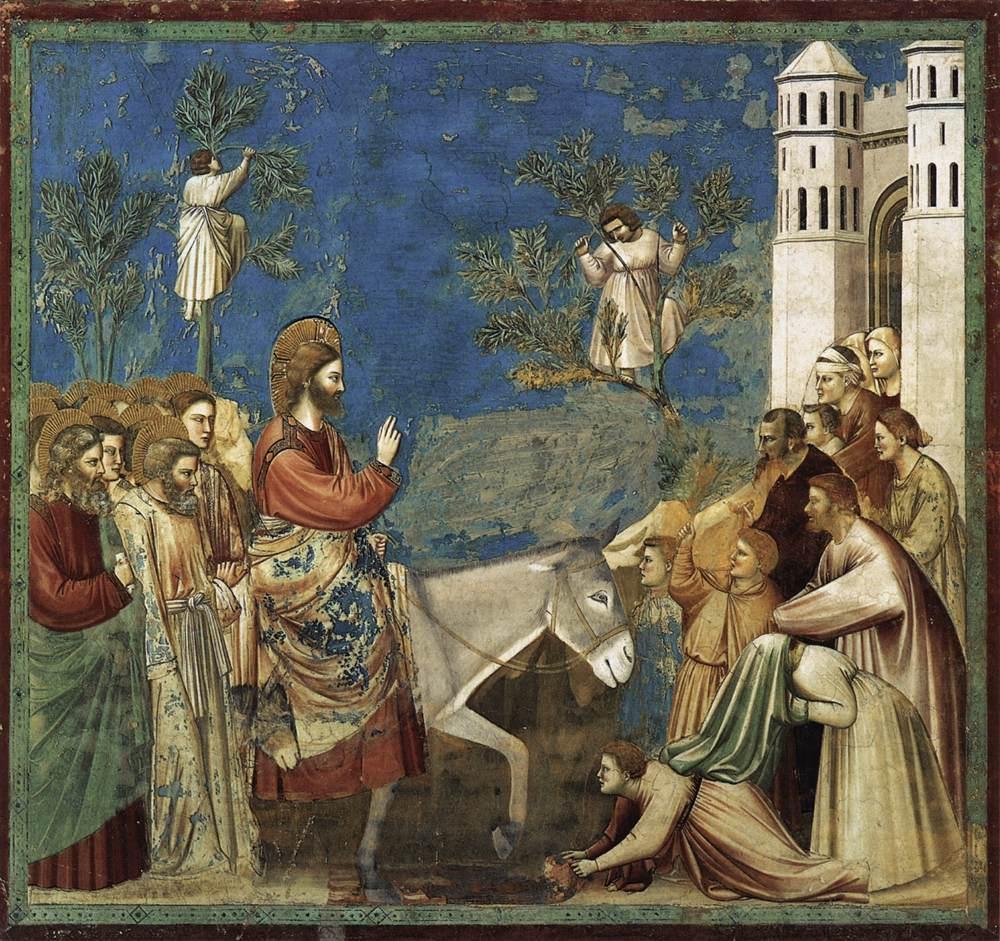 |
Domingo de Ramos. Entrada
triunfal de Jesucristo en Jerusalén. 棕櫚の日曜日。イエス・キリストの エルサレム凱旋。 |
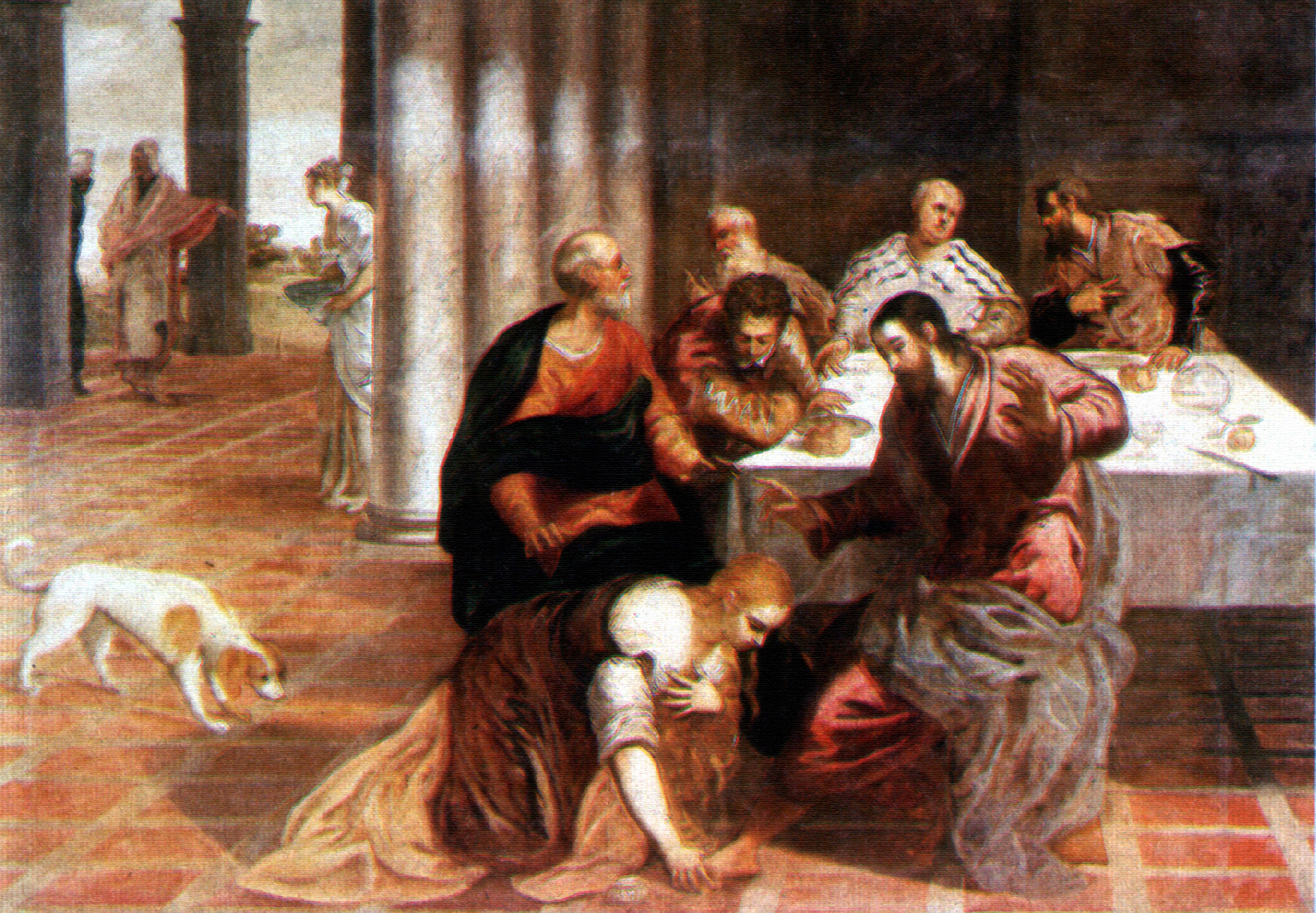 |
Lunes Santo. Unción de Jesús en
casa de Lázaro. Jesús expulsa a los mercaderes del Templo de Jerusalén. イースターの月曜日 ラザロの家でイエスの油注ぎ。イエスはエルサレムの神殿から商人たちを追い出される。 |
 |
Martes Santo. Jesús anticipa a
sus discípulos la traición de Judas y las Negaciones de San Pedro. 聖火曜日 イエスは弟子たちにユダの裏切りと聖ペトロの否認を予言する。 |
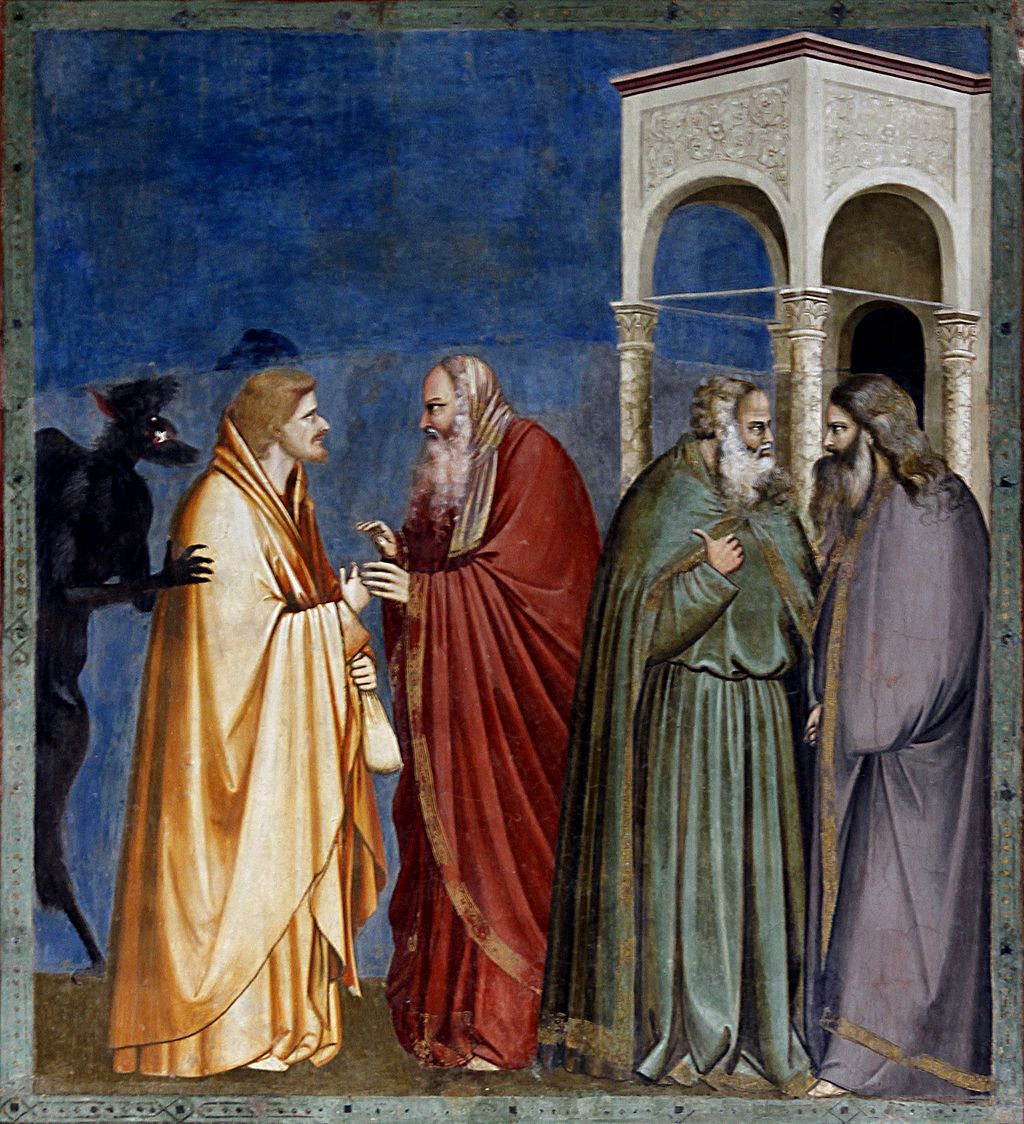 |
Miércoles Santo. Judas Iscariote
conspira con el Sanedrín para traicionar a Jesús por treinta monedas de
plata. 聖水曜日。イスカリオテのユダはサンヒドリンと共謀し、銀貨30枚でイエスを裏切る。 |
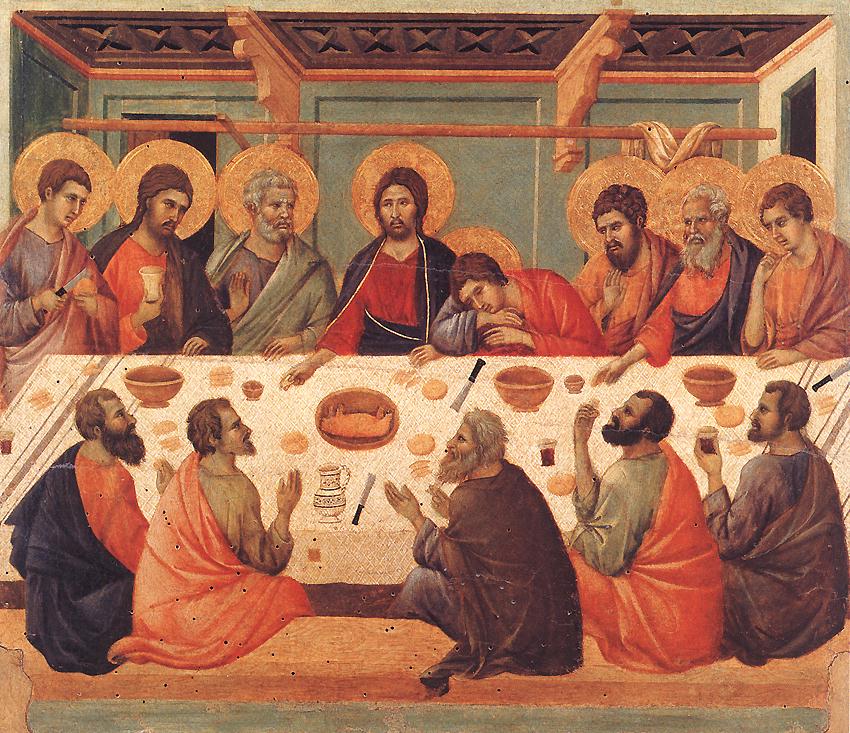 |
Jueves Santo. Lavatorio de los
pies. La Última Cena. Eucaristía. Oración de Jesús en el huerto de
Getsemaní. Arresto de Jesús. 聖木曜日 足を洗う。最後の晩餐。聖体拝領。ゲッセマネの園でのイエスの祈り。イエスの逮捕。 |
 |
Viernes Santo. Prisión de Jesús.
Los interrogatorios de Caifás y Pilato. La flagelación. La coronación
de espinas. Vía Crucis. Crucifixión de Jesús. Sepultura de Jesús. 聖金曜日 イエスの投獄 カイアファとピラトの尋問。鞭打ち。いばらの冠 十字架の道 イエスの十字架刑。イエスの埋葬。 |
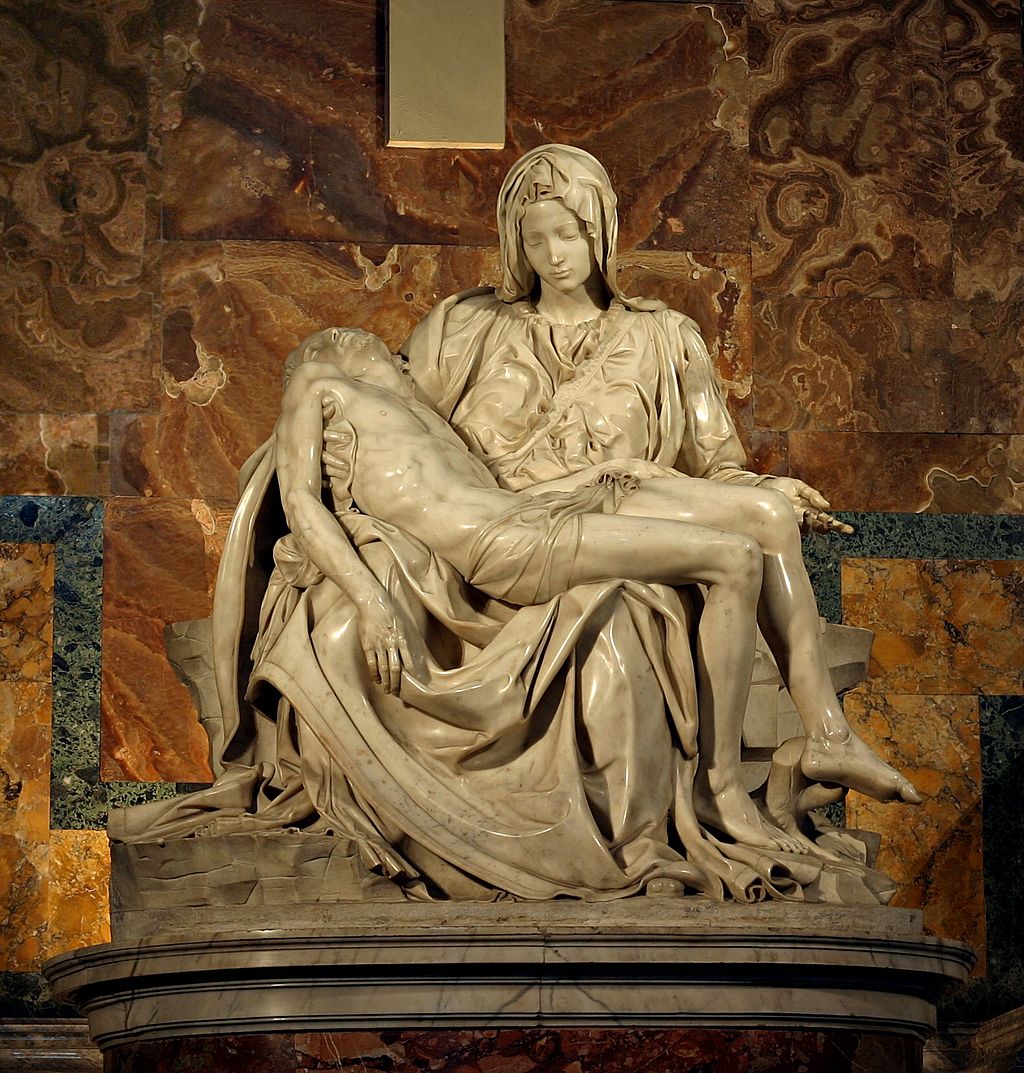 |
Sábado Santo. La Soledad de
María, Víspera de Pascua. 聖土曜日 マリアの孤独、イースター・イブ。 |
 |
Domingo de Pascua. La
Resurrección. イースターの日曜日 復活。 |
Holy Week in Western Christianity
| Palm Sunday (Sixth
Sunday of Lent) Main article: Palm Sunday Further information: Passion Sunday Holy Week begins with Palm Sunday, complete: Palm and Passion Sunday (Latin Dominica in Palmis de Passione Domini). Traditionally, Palm Sunday commemorates the Triumphal entry into Jerusalem described in all four canonical gospels. As described in these accounts, Christ's entry into Jerusalem was noted by the crowds present who shouted praises and waved palm branches. In the Roman Rite, before 1955 it was known simply as Palm Sunday, and the preceding Sunday as Passion Sunday. From 1955 to 1971 it was called Second Sunday in Passiontide or Palm Sunday. Among Lutherans and Anglicans, the day is known as the Sunday of the Passion: Palm Sunday.[17] In many liturgical denominations, to commemorate Christ's entry into Jerusalem to accomplish his paschal mystery, it is customary to have a blessing of palm leaves or other branches, for example olive branches. The blessing ceremony includes the reading of a Gospel account of Jesus humbly riding into Jerusalem on a donkey, reminiscent of a Davidic victory procession, and people placing palm and other branches on the ground before him. Immediately following this great time of celebration over the entrance of Jesus into Jerusalem, he begins his journey to the cross. The blessing is thus followed by a procession or solemn entrance into the church, with the participants holding the blessed branches in their hands. The liturgy includes the solemn reading of the Passion, the narrative of Christ's capture, suffering and death, as recounted in one of the Synoptic Gospels. (In the Tridentine Mass the Passion is always that of St. Matthew.)[18] 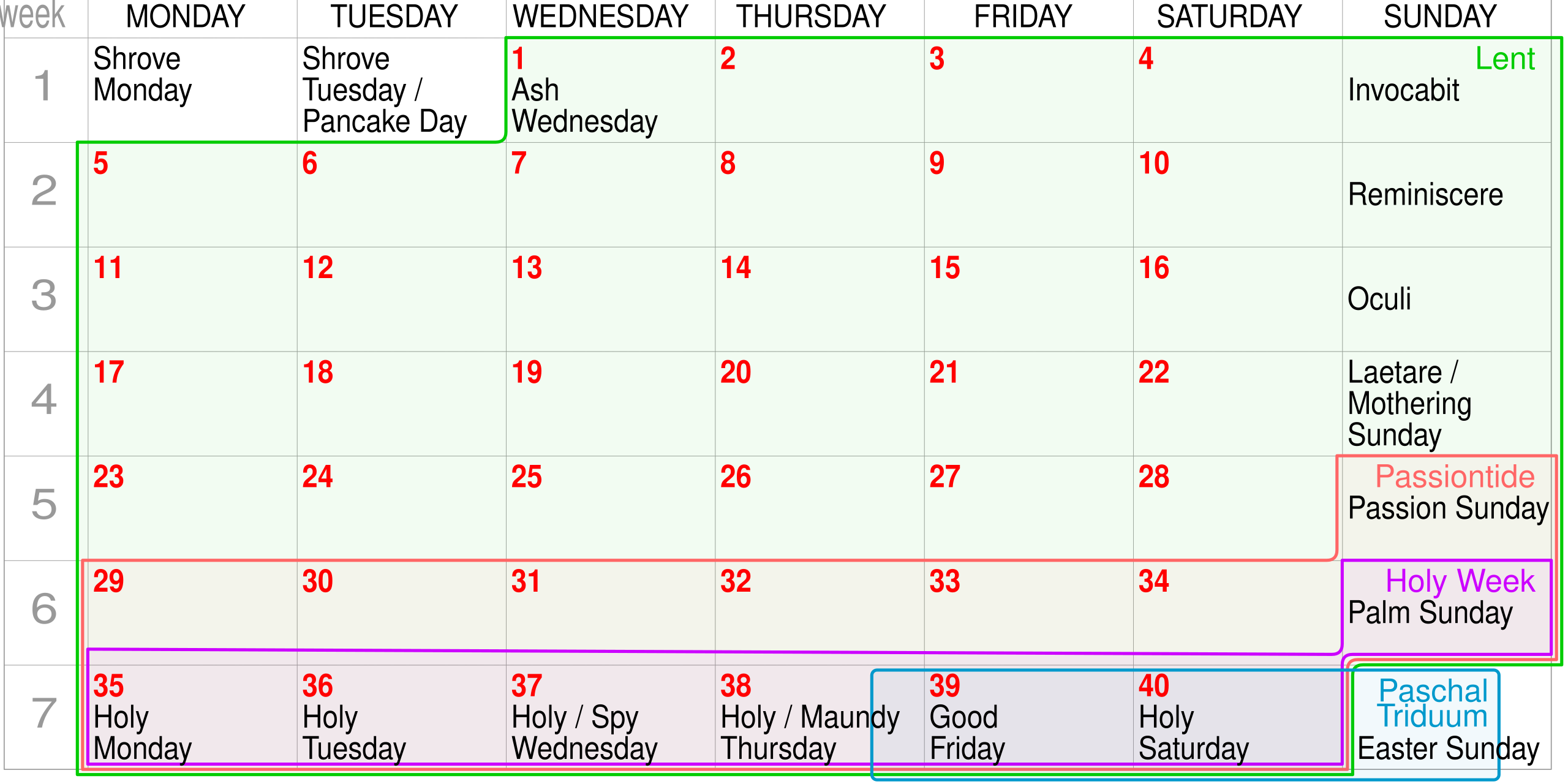 Holy Week and other named days and day ranges around Lent and Easter in Western Christianity, with the fasting days of Lent numbered Before the reform of the rite by Pope Pius XII, the blessing of the palms occurred inside the church within a liturgy that followed the general outline of a Mass, with Collect, Epistle and Gospel, as far as the Sanctus. The palms were then blessed with five prayers, and a procession went out of the church and on its return included a ceremony for the reopening of the doors, which had meanwhile been shut. After this the normal Mass was celebrated.[19] Churches of many denominations, including the Lutheran, Catholic, Methodist, Anglican, Moravian and Reformed traditions, distribute palm branches to their congregations during their Palm Sunday liturgies. Christians take these palms, which are often blessed by clergy, to their homes where they hang them alongside Christian art (especially crosses and crucifixes) or keep them in their Bibles or devotionals.[20] |
棕櫚の主日(四旬節の第6主日) 詳細は「棕櫚の主日」を参照 関連情報:「受難日」 聖週間は棕櫚の主日に始まり、棕櫚の主日と受難日(ラテン語:Dominica in Palmis de Passione Domini)で完結する。伝統的に、棕櫚の主日は正典福音書4書すべてに記述されているエルサレム入場を記念するものである。これらの記述によると、エ ルサレムに入場したキリストは、その場に居合わせた群衆から賞賛の声を浴び、棕櫚の枝を振って迎えられた。ローマ典礼では、1955年以前は単に「棕櫚の 主日」と呼ばれ、その前の主日は「受難主日」と呼ばれていた。1955年から1971年までは「受難節第2主日」または「棕櫚の主日」と呼ばれていた。 ルーテル派や聖公会では、この日は「受難の日:棕櫚の主日」として知られている。 多くの典礼的宗派では、キリストが過越の神秘を成し遂げるためにエルサレムに入城したことを記念して、棕櫚の葉やその他の枝、例えばオリーブの枝を祝福す る慣習がある。祝福の儀式では、イエスが謙虚にロバに乗ってエルサレムに入城したという福音書の記述が朗読され、ダビデの勝利の行進を彷彿とさせる。ま た、人々はイエスの前で棕櫚やその他の枝を地面に置く。 イエスがエルサレムに入場したことを祝うこの盛大な行事が終わると、すぐにイエスは十字架への旅を始める。 祝福の儀式の後には、祝福された枝を手にした参加者が教会への厳粛な入場行進を行う。 典礼には、共観福音書の一つに記されたキリストの捕縛、苦しみ、死の物語である受難の厳粛な朗読が含まれる。(トリエント・ミサでは受難は常に聖マタイの ものとなる)[18]  西方キリスト教における聖週間およびその他の祝日、四旬節と復活祭の間の期間、四旬節の断食日には番号が振られる 教皇ピウス12世による典礼改革以前は、棕櫚の祝福はミサの大まかな概要に従った典礼の中で、コレクト、書簡、福音書、サンクタスまで教会の中で行われて いた。その後、5つの祈りを捧げて棕櫚の枝が祝福され、行列が教会の外に出て、戻ってくる際に、その間閉められていた扉を再び開ける儀式が行われた。その 後、通常のミサが行われた。[19] ルーテル派、カトリック、メソジスト派、聖公会、モラビア派、改革派など、多くの宗派の教会では、棕櫚の枝を棕櫚の主日の典礼中に信者に配布している。キ リスト教徒は、聖職者から祝福を受けたこれらの棕櫚の枝を自宅に持ち帰り、キリスト教美術(特に十字架やキリスト磔刑像)の傍らに飾ったり、聖書や信仰書 と一緒に保管したりする。[20] |
| Holy Monday and Holy Tuesday Holy Tuesday in Venezuela The days between Palm Sunday and Maundy Thursday are known as Holy Monday, Holy Tuesday (Fig Tuesday), and Holy Wednesday (Spy Wednesday). There are traditional observances held by liturgical denominations to commemorate events from the last days of Jesus Christ's life. Among them:  On Holy Monday, events observed in the liturgy may include Jesus cursing the fig tree, the cleansing of the Temple, the authority of Jesus questioned, and the anointing of Jesus at Bethany (John 12:1–11), an event that in the Gospel of John occurred before Palm Sunday as in John 12:12–19. On Holy Tuesday, some observe Christ's predictions of his own death, as described in John 12:20–36 and John 13:21–38. (In the Tridentine Mass the Passion according to St. Mark is read instead.) |
聖月曜日と聖火曜日 ベネズエラにおける聖火曜日 棕櫚の主日(枝の主日)から洗足木曜日までの期間は、それぞれ聖月曜日、聖火曜日(無花果の火曜日)、聖水曜日(スパイの水曜日)と呼ばれる。典礼的宗派 では、イエス・キリストの生涯の最後の数日間を記念する伝統的な儀式が行われる。その中には、  聖月曜日には、典礼で祝われる出来事として、イエスがイチジクの木を呪ったこと、神殿の清め、イエスの権威が疑われたこと、ベタニアでのイエスの油注ぎ (ヨハネによる福音書12:1-11)などがある。ヨハネによる福音書12:12-19にあるように、この出来事は棕櫚の主日の前に起こったとされてい る。 聖火曜日には、ヨハネによる福音書第12章20節から第36節と第13章21節から第38節に記されているキリスト自身の死の予言を信じる人々もいる。 (トリエント・ミサでは、代わりに聖マルコによる受難が読まれる。) |
| Holy Wednesday (Spy Wednesday) Main article: Holy Wednesday On Holy Wednesday,[21] the story of Judas arranging his betrayal of Jesus with the chief priests is remembered; he was a spy among the disciples of Jesus (Matthew 26:14–25).[22] For this reason, the day is sometimes called "Spy Wednesday".[1] (In the Tridentine Mass the Passion according to St. Luke is read instead.) Other events connected with this date include events at the house of Simon the Leper, especially the anointing of Jesus by Mary of Bethany, which directly preceded the betrayal of Jesus by Judas to the Sanhedrin.[23] Tenebrae (Latin for "shadows" or "darkness") is celebrated within Western Christianity during Holy Week, especially on Spy Wednesday.[24][25] Tenebrae is distinctive for its gradual extinguishing of candles while a series of readings and psalms is chanted or recited. Tenebrae liturgies are celebrated by some parishes of the Roman Rite of the Catholic Church, the Polish National Catholic Church, the Lutheran Churches, the Moravian Church, the Anglican Communion, the Methodist Churches, and Western Rite Orthodoxy within the Eastern Orthodox Church.[26] |
聖なる水曜日(スパイ・ウェンズデー) 詳細は「聖なる水曜日」を参照 聖なる水曜日には、祭司長たちとイエスの裏切りを画策したユダの物語が想起される。彼はイエスの弟子たちの間ではスパイであった(マタイによる福音書 26:14-25)。 このため、この日は「スパイ・ウェンズデー」と呼ばれることもある。(トリエント・ミサでは、代わりに聖ルカによる受難が読まれる。)この日付に関連する その他の出来事としては、シモン・ザ・レパーの家での出来事、特にベタニアのマリアによるイエスの油注ぎが挙げられる。これは、ユダによるイエスのサンヘ ドリンへの裏切りの直前に起こった出来事である。 テネブレ(ラテン語で「影」または「闇」の意)は、西方教会では聖週の間、特にスパイの水曜日に祝われる。[24][25] テネブレは、一連の朗読や詩篇が唱えられたり朗読されたりする中で、徐々にろうそくが消されていくのが特徴である。テネブレの典礼は、ローマ・カトリック 教会のいくつかの教区、ポーランド国民カトリック教会、ルーテル教会、モラヴィア教会、聖公会、メソジスト教会、および東方正教会内の西方礼儀正教によっ て行われている。[26] |
| Maundy Thursday Main article: Maundy Thursday Further information: Mass of the Lord's Supper and Stripping of the Altar 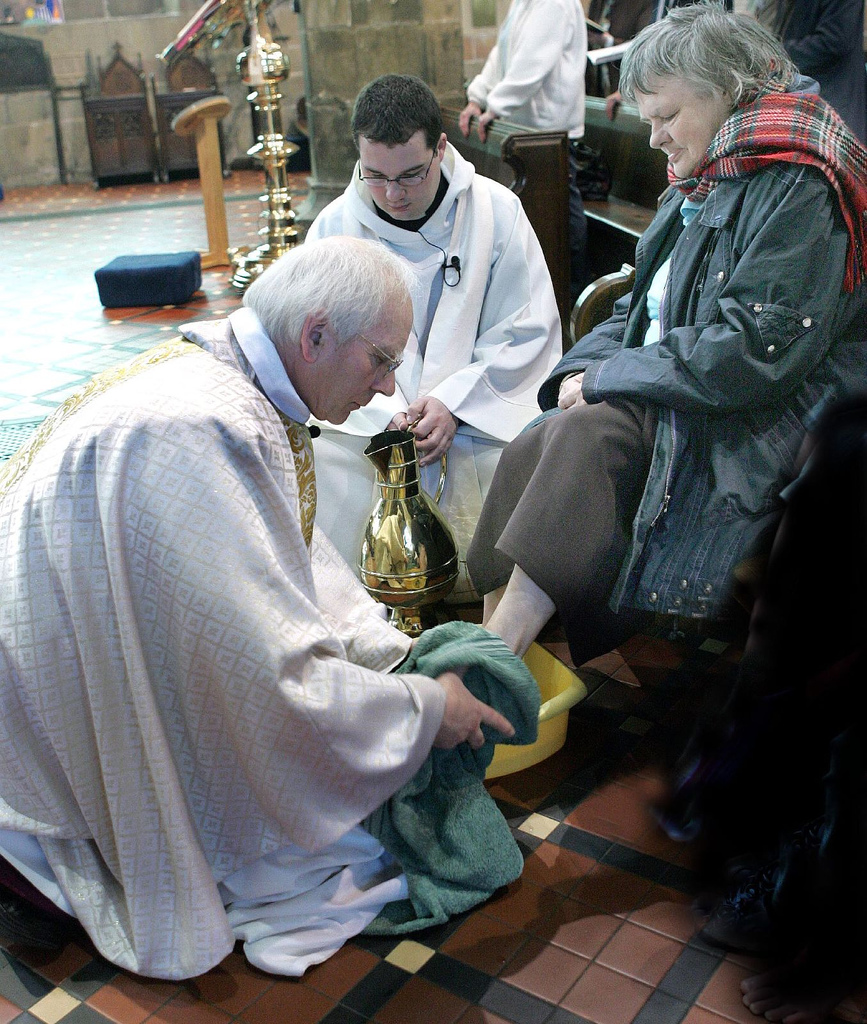 Maundy Thursday ceremony in a Church in Wales parish church during a Maundy Thursday service of worship 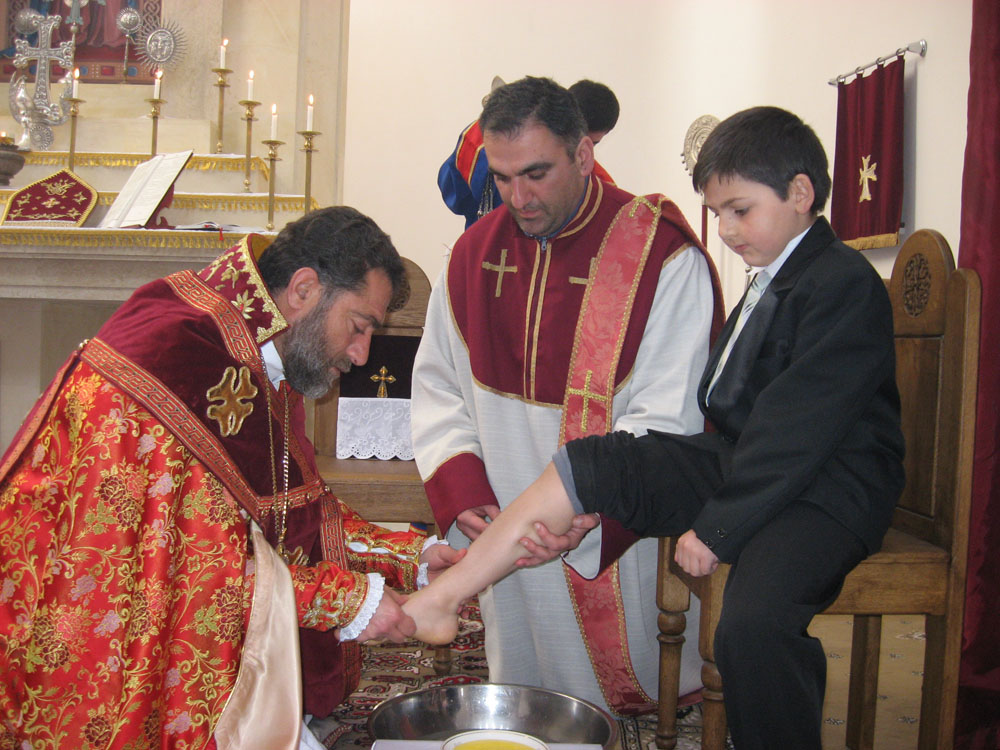 A Washing of Feet ceremony on Holy Thursday in the Armenian Orthodox church 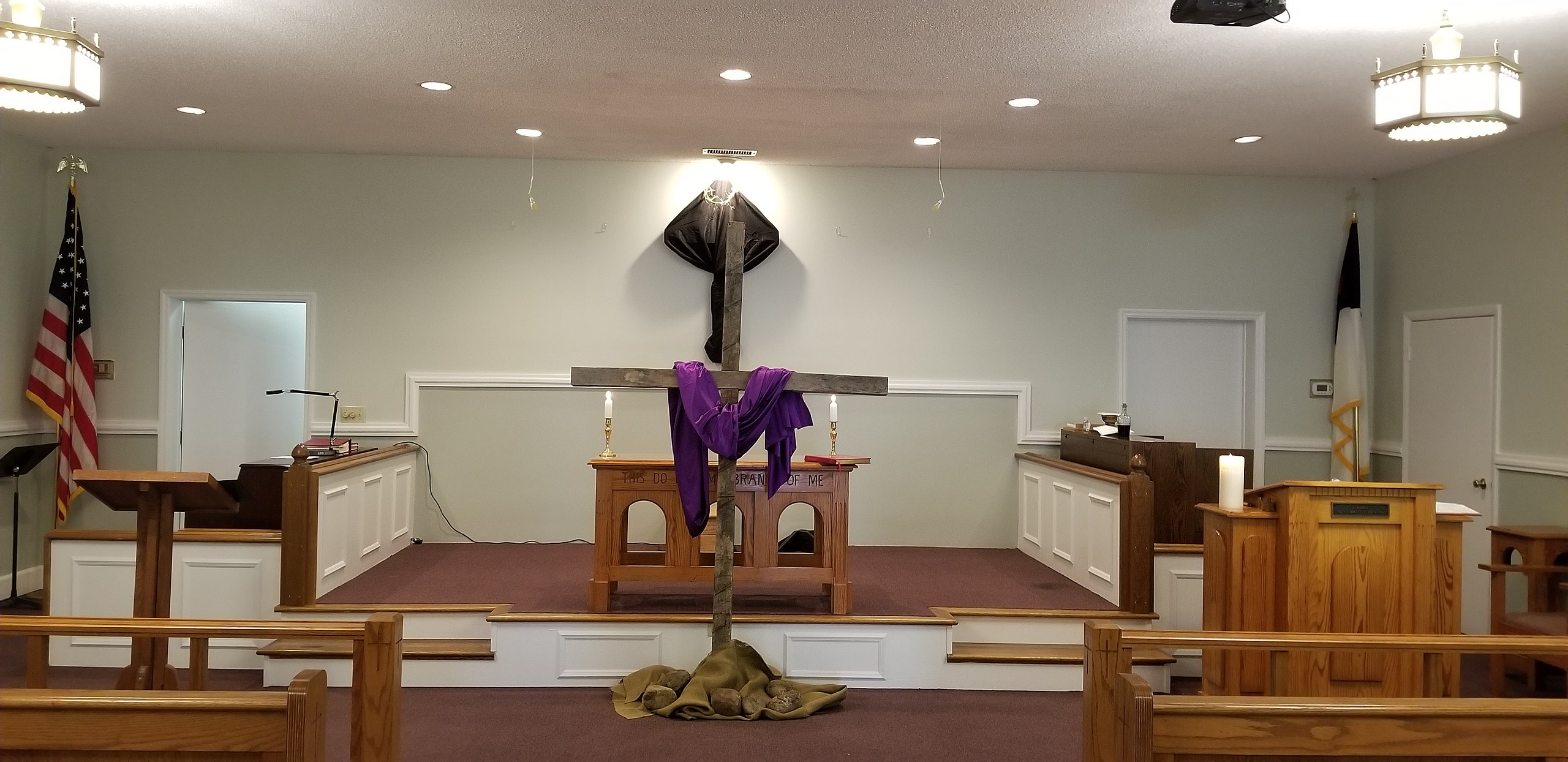 On Maundy Thursday, the altar of this Methodist church was stripped and the crucifix was veiled in black for Good Friday. A wooden cross sits in front of the bare chancel for the veneration of the cross ceremony. Maundy Thursday (also known as Holy Thursday) commemorates the Last Supper, where Christ lays out the model for the Eucharist or Holy Communion. During the meal, Jesus predicted the events that would immediately follow, including his betrayal, the Denial of Peter, and his death and resurrection. The liturgical celebration of the Last Supper on Maundy Thursday marks the beginning of the Paschal Triduum. Catholic and Lutheran parishes traditionally practice the foot washing (Maundy) ceremony on Maundy Thursday, a practice also kept in other denominations.[27] In the Catholic Church, on this day the private celebration of Mass is forbidden.[28] Thus, apart from the Chrism Mass for the blessing of the Holy Oils that the diocesan bishop may celebrate on the morning of Holy Thursday, but also on some other day close to Easter, the only Mass on this day is the evening Mass of the Lord's Supper, which inaugurates the period of three days known as the Easter Triduum, that includes Good Friday (seen as beginning with the liturgy of the preceding evening), Holy Saturday and Easter Sunday up to evening prayer on that day.[29] The Chrism Mass, whose texts the Roman Missal and the rubrics used in Lutheran Churches now give under Maundy Thursday, but before the Paschal Triduum which begins that evening, may be brought forward early in Holy Week, to facilitate participation by as many clergy of the diocese as possible together with the bishop.[30] This Mass was not included in editions of the Roman Missal before the time of Pope Pius XII. In this Mass, the bishop blesses separate oils for the sick (used in Anointing of the Sick), for catechumens (used in baptism) and chrism (used in baptism, confirmation and the Holy Orders, as well as in rites such as the dedication of an altar and a church).[31] The Mass of the Lord's Supper commemorates the Last Supper of Jesus with his Twelve Apostles, "the institution of the Eucharist, the institution of the priesthood, and the commandment of brotherly love that Jesus gave after washing the feet of his disciples."[32] All the bells of the church, including altar bells, may be rung during the Gloria in Excelsis Deo of the Mass (the Gloria is not traditionally sung on Sundays in Lent). The bells then fall silent and the organ and other musical instruments may be used only to support the singing until the Gloria at the Easter Vigil.[33][27] The Roman Missal recommends that, if considered pastorally appropriate, the priest should, immediately after the homily, celebrate the rite of washing the feet of customarily twelve men, recalling the number of the apostles.[34] In the Catholic Church, Lutheran Churches of Evangelical Catholic churchmanship, and in Anglican churches of an Anglo-Catholic churchmanship, a sufficient number of hosts are consecrated for use also in the Good Friday liturgy, and at the conclusion the Blessed Sacrament is carried in procession to a place of reposition away from the main body of the church, which, if it involves an altar, is often called an "altar of repose".[35][27] In some places, notably the Philippines and Malta, Catholics will travel from church to church praying at each church's altar of repose in a practice called "Visita Iglesia" or Seven Churches Visitation. In Lutheran, Anglican and Methodist churches, the altar has black paraments or the altar cloths are removed altogether.[36][37] At the conclusion of the Maundy Thursday liturgy in Lutheran Churches, the "lectern and pulpit are [also] left bare until Easter to symbolize the humiliation and barrenness of the cross."[38] Methodist custom holds that apart from depictions of the Stations of the Cross, other images (such as the altar cross) continue the Lenten habitude of being veiled.[39] In the Catholic Church, the altars of the church (except the one used as the altar of repose) are later stripped quite bare and, as much as possible, crosses are removed from the church (or veiled in the pre-Vatican II rite), crucifixes and statues are covered with violet covers during Passiontide, but the crucifix covers can be white instead of violet on Maundy Thursday).[40] |
洗足木曜日 詳細は「洗足木曜日」を参照 詳細は「主の晩餐のミサ」および「祭壇の撤去」を参照  ウェールズの教区教会における洗足木曜日の儀式  聖木曜日に行われるアルメニア正教会の洗足式  聖木曜日、このメソジスト教会の祭壇は取り払われ、十字架は黒いベールで覆われた。十字架崇敬式のために、木製の十字架がむき出しの聖歌隊席の前に置かれている。 聖木曜日(聖木曜日とも呼ばれる)は、キリストが聖餐式または聖体拝領のモデルを示した最後の晩餐を記念する日である。食事の間、イエスは直後に起こる出 来事、すなわち、裏切り、ペトロの否認、そして死と復活を予言した。洗足木曜日に行われる最後の晩餐の典礼上の祝いは、復活祭の三日間(パスカル・トリ デュウム)の始まりを告げる。カトリックとルーテル派の教区では、伝統的に洗足木曜日(マウントデイ)に洗足式(マウントデイ)を行う。この慣習は他の宗 派でも守られている。 カトリック教会では、この日はミサの私的な祝いは禁じられている。[28] したがって、聖木曜日の朝に教区司教が執り行う聖油の祝福のための聖油ミサは、復活祭に近い別の日にも行われるが、 この日に執り行われるミサは、主の晩餐の夕方のミサのみであり、このミサは、聖金曜日(前夜の典礼から始まるものと見なされる)、聖土曜日、復活祭の日曜 日(その日の夕方の祈りまで)を含む、復活祭の三日間と呼ばれる3日間の期間の始まりを告げるものである。 [29] 聖香油のミサは、ローマ・ミサ典礼書およびルーテル教会で使用されているルブリカ(注釈)では、洗足木曜日に行われることになっているが、その日の夕方に 始まる復活祭の三日間より前に行われることもある。これは、司教とともにできるだけ多くの教区司祭が参加できるようにするためである。[30] このミサは、教皇ピウス12世の時代以前のローマ・ミサ典礼書の版には含まれていなかった。このミサでは、司教が病者のための油(病者の塗油で使用)、洗 礼志願者のための油(洗礼で使用)、聖香油(洗礼、堅信礼、聖職授任で使用されるほか、祭壇や教会の献堂式などの儀式でも使用される)をそれぞれ祝福す る。[31] 主の晩餐のミサは、イエスが十二使徒たちと共にした最後の晩餐を記念するものであり、「聖餐式の制定、聖職の制定、そしてイエスが弟子たちの足を洗った後 に与えた兄弟愛の戒め」を記念するものである。[32] ミサのGloria in Excelsis Deoの間は、祭壇の鐘を含め、教会のすべての鐘を鳴らすことができる(四旬節の日曜には伝統的にグロリアは歌われない)。その後、鐘は鳴り止み、復活祭 の徹夜祭のグローリアまで、オルガンやその他の楽器は歌をサポートするためにのみ使用される。[33][27] ローマ・ミサ典礼では、司祭が説教の直後に、適切であると判断される場合には、使徒の数を想起して、通常12人の信者の足を洗う儀式を行うことが推奨され ている。[34] カトリック教会、福音ルーテル教会、およびアングロ・カトリック教会の聖公会では、聖体は十分な数が聖金曜日の典礼でも使用できるように聖別され、典礼の 終わりには聖体が行列で教会本体から離れた安置場所に運ばれる。 [35][27] フィリピンやマルタなど一部の地域では、カトリック信者が教会から教会へと移動し、それぞれの教会の安息の祭壇で祈りを捧げる「ヴィシタ・イグレシア」ま たは「七つの教会訪問」と呼ばれる慣習がある。 ルーテル教会、聖公会、メソジスト教会では、祭壇は黒いパラメントで覆われるか、祭壇布は完全に撤去される。[36][37] ルーテル教会では、聖木曜日の典礼の終了時に、「聖書台と説教壇は、十字架の屈辱と不毛を象徴するために、復活祭までむき出しのままにしておく」[38] [38] メソジスト派の慣習では、十字架の道行きの描写を除いて、他の画像(祭壇の十字架など)は四旬節の習慣に従って覆いをかけたままにする。 [39] カトリック教会では、教会の祭壇(安置祭壇として使用されているものを除く)は後でかなり簡素化され、可能な限り、十字架は教会から撤去される(またはバ チカン2世以前の儀式では覆い隠される)。受難節の間は、十字架や像はすみれ色のカバーで覆われるが、洗足木曜日には、十字架のカバーはすみれ色ではなく 白にすることができる。[40] |
| Good Friday Main article: Good Friday 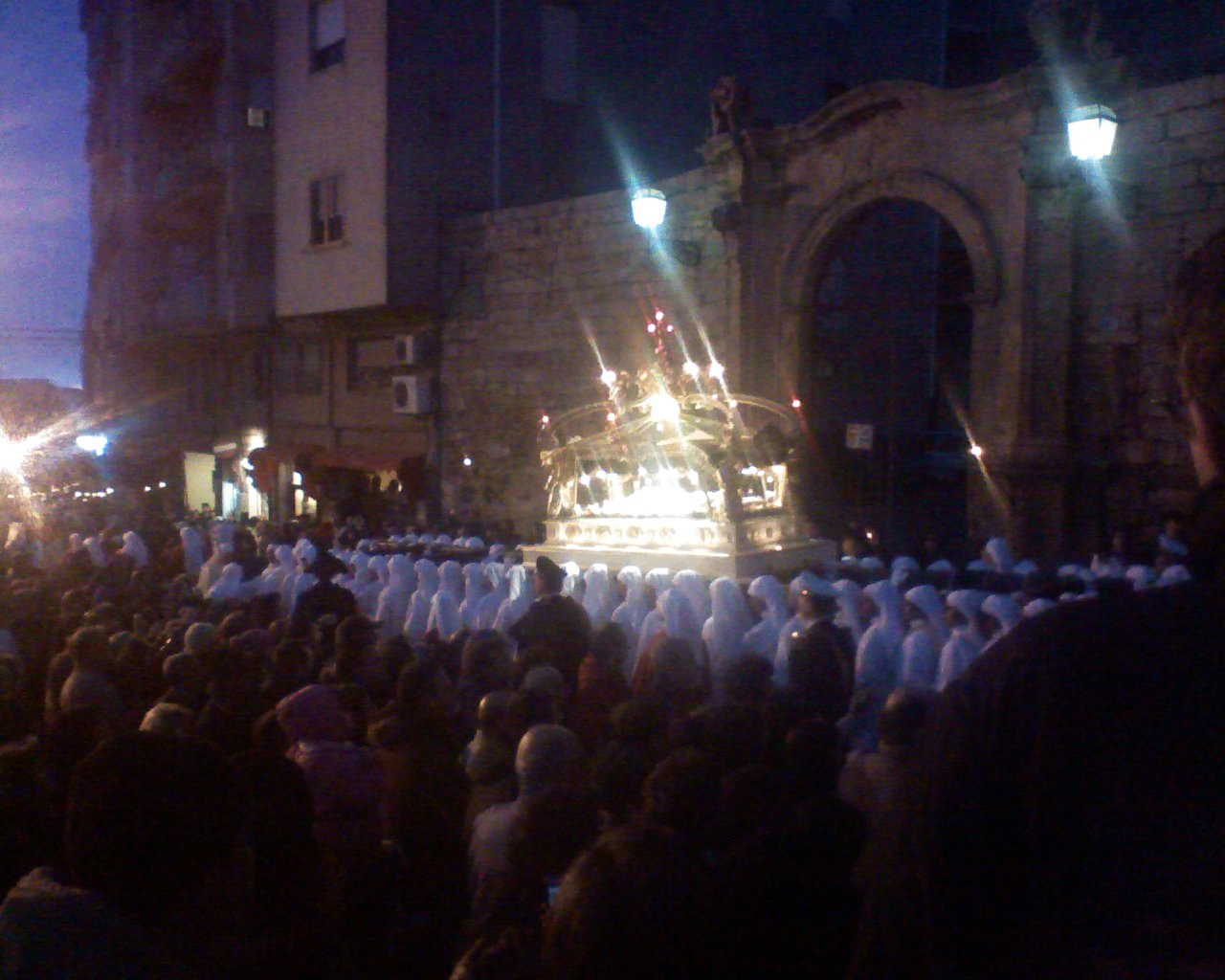 Good Friday in Enna, Italy 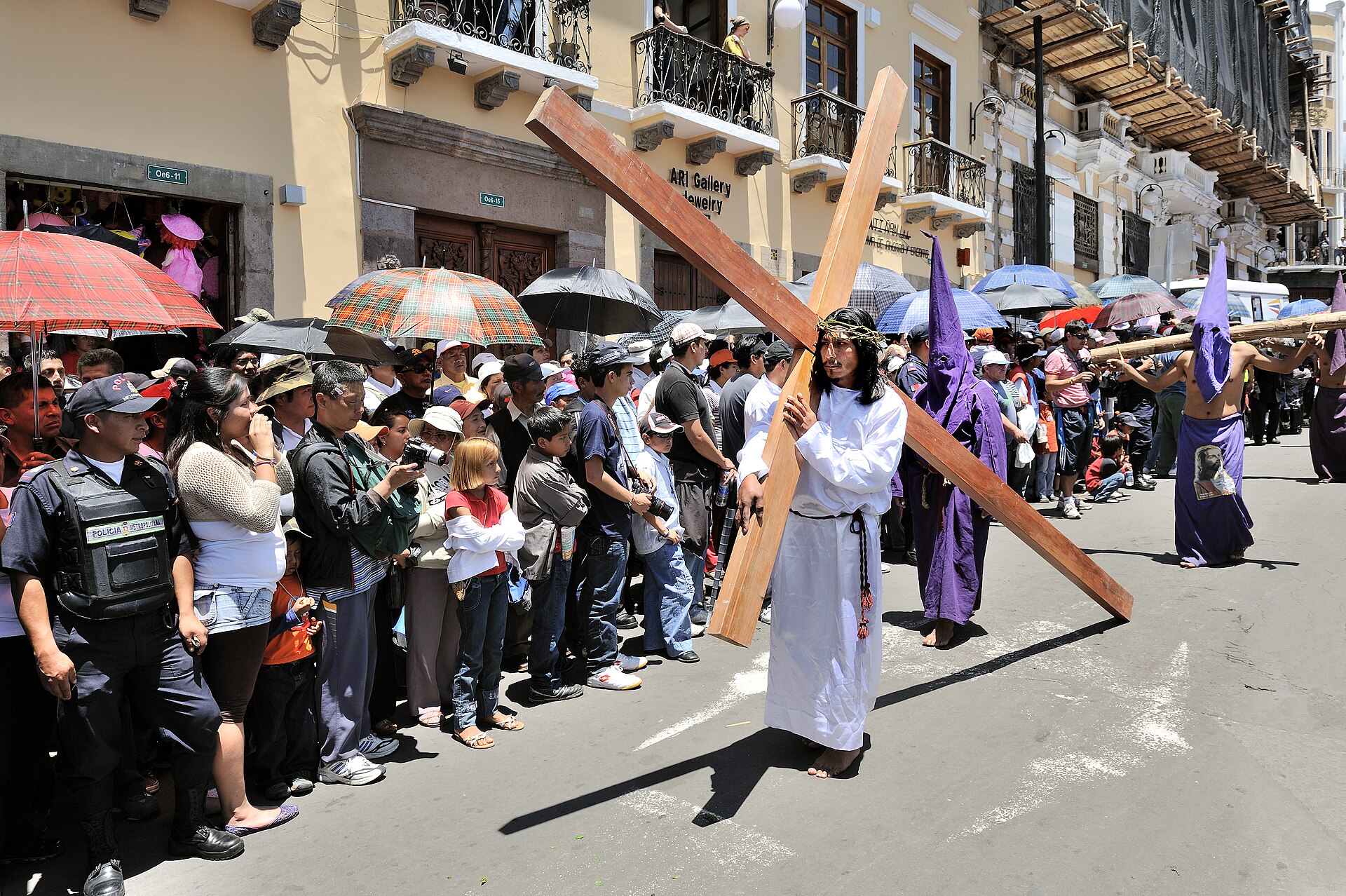 A Good Friday procession in Ecuador. The man is shown holding a cross, representing the one upon which Jesus was crucified. A Good Friday procession in Ecuador. The man is shown holding a cross, representing the one upon which Jesus was crucified.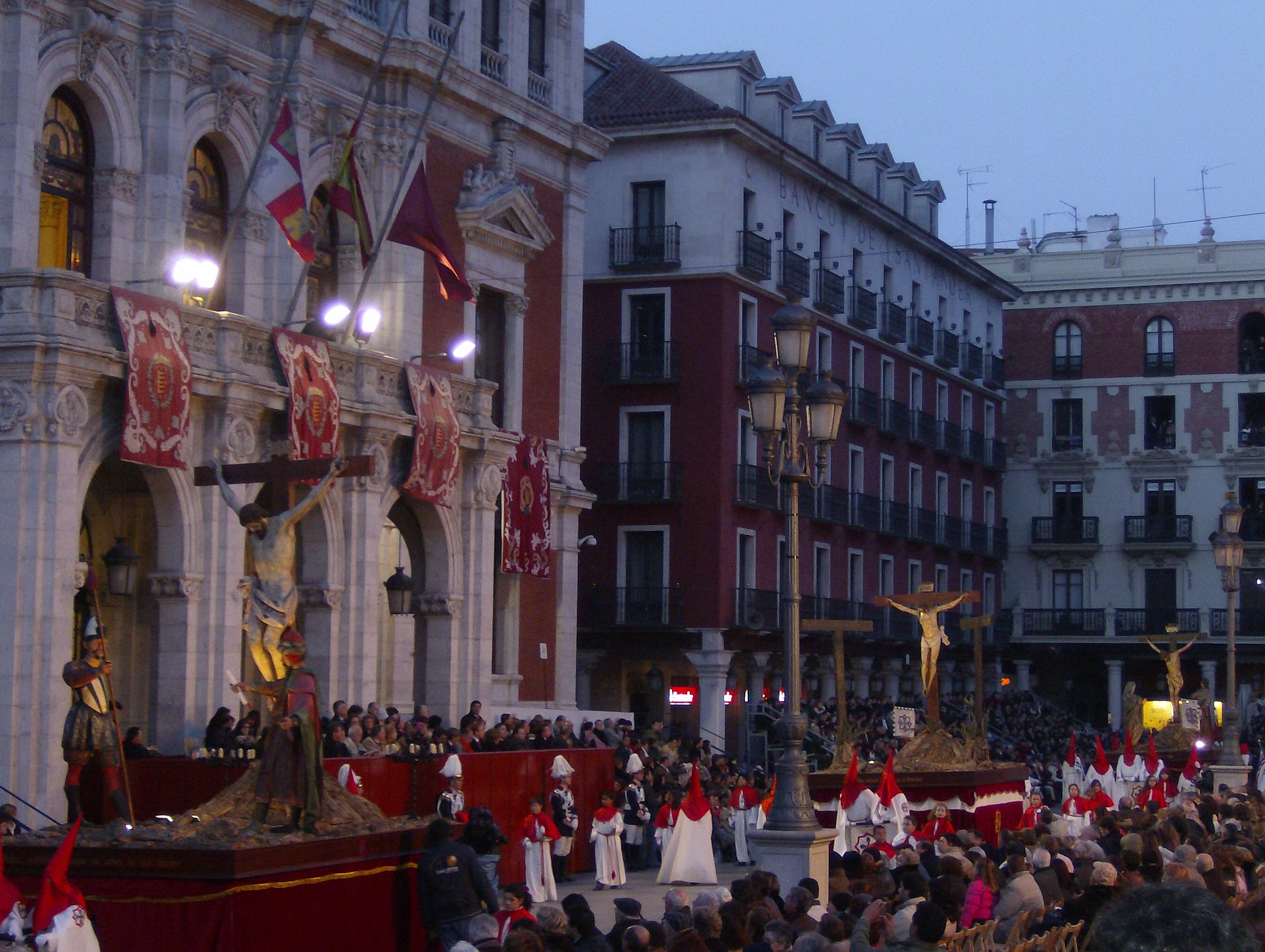 The General Good Friday Procession in Valladolid, Spain in front of the City Hall.  A traditional procession of the "Barette", showing the passion of Christ, the Good Friday in Messina, Sicily, Italy Good Friday commemorates the crucifixion of Jesus and his subsequent death. Commemorations of often solemn and mournful, many denominations use Good Friday to perform the Stations of the Cross, or other commemorations of the Passion, either as a self-guided time of reflection and veneration or as a procession of statues or images of the stations.[citation needed] The evening liturgical celebration on Holy Thursday begins the first of three days in the Easter Triduum, which continues in an atmosphere of liturgical mourning throughout the next day, in spite of the name "Good" given in English to the day.[citation needed] For Catholic, Methodist, Lutheran, Reformed and Anglican Christians, Good Friday is widely observed as a fast day.[41] A Handbook for the Discipline of Lent recommends the Lutheran guideline to "fast on Ash Wednesday and Good Friday with only one simple meal during the day, usually without meat".[42] Western Catholic Church practice is to have only one full meal with, if needed, two small snacks that together do not make a full meal. The Anglican Communion defines fasting more generically as: "The amount of food eaten is reduced."[43] In some countries, such as Malta, Philippines, Italy, and Spain processions with statues representing the Passion of Christ are held. The church mourns for Christ's death, reveres the cross, and marvels at his life for his obedience until death. In the Catholic Church, the only sacraments celebrated are Penance and Anointing of the Sick. While there is no celebration of the Eucharist, Holy Communion is distributed to the faithful only in the Celebration of the Lord's Passion, but can be taken at any hour to the sick who are unable to attend this liturgy. Outside the afternoon liturgical celebration, the altar remains completely bare in Catholic churches, without altar cloth, candlesticks, or cross. In Lutheran and Methodist churches, the altar is usually draped in black. It is customary to empty the holy water fonts in preparation for the blessing of the water at the Easter Vigil.[44] The Celebration of the Passion of the Lord takes place in the afternoon, ideally at three o'clock, but for pastoral reasons a later hour may be chosen. In the Catholic Church the colour of the vestments is red. The Lutheran Church, Methodist Church, and Presbyterian Church continue to use black, as was the practice of the Catholic Church until 1970. If a bishop celebrates, he wears a plain mitre. The Roman Rite liturgy consists of three parts: the Liturgy of the Word, the Veneration of the Cross, and Holy Communion. Liturgy of the Word Prostration of the celebrant before the altar. The readings from Isaiah 53 (about the Suffering Servant) and the Epistle to the Hebrews are read. The Passion narrative of the Gospel of John is sung or read, often divided between more than one singer or reader. General Intercessions: The congregation prays for the Church, the Pope, the Jews, non-Christians, unbelievers and others. Veneration of the Cross: A crucifix is solemnly unveiled before the congregation. The people venerate it on their knees. During this part, the "Reproaches" are often sung. Distribution of Holy Communion: Hosts consecrated at the Mass of the previous day are distributed to the people. (Before the reform of Pope Pius XII, only the priest received Communion in the framework of what was called the "Mass of the Presanctified", which included the usual Offertory prayers, with the placing of wine in the chalice, but which omitted the Canon of the Mass.[19]) The Good Friday liturgy is not a Mass, and in fact, celebration of Catholic Mass on Good Friday is forbidden. It is the Eucharist consecrated the evening before (Holy Thursday) that is distributed. Even if music is used in the Liturgy, it is not used to open and close the Liturgy, nor is there a formal recessional (closing procession). The solemnity and somberness of the occasion has encouraged the persistence over the centuries of liturgical forms without substantial modification. It was once customary in some countries, especially England, to place a veiled monstrance with the Blessed Sacrament or a cross in a Holy Sepulchre.[45] If crucifixes were covered starting with the next to last Sunday in Lent, they are unveiled without ceremony after the Good Friday liturgy. In some parishes of the Anglican Church, Catholic Church, Lutheran Church, and Methodist Church, the "Three Hours Devotion" is observed. This traditionally consists of a series of sermons, interspersed with singing, one on each of the Seven Last Words from the Cross, together with an introduction and a conclusion.[46][47] Another pious exercise carried out on Good Friday is that of the Stations of the Cross, either within the church or outside. The celebration at the Colosseum with participation by the pope has become a traditional event.[48] The Novena to the Divine Mercy begins on that day and lasts until the Saturday before the Feast of Mercy.[49][50] Moravians hold a Lovefeast on Good Friday as they receive Holy Communion on Maundy Thursday. Communicants of the Moravian Church practice the Good Friday tradition of cleaning gravestones in Moravian cemeteries.[51] |
聖金曜日 詳細は「聖金曜日」を参照  イタリアのエンナにおける聖金曜日  エクアドルにおける聖金曜日の行列。男が十字架を持っているのは、イエスが磔にされた十字架を表している。  スペイン、バリャドリッドの市庁舎前で行われる聖金曜日大行列。  キリストの受難を表す「バレッタ」の伝統的行列、シチリア島メッシーナの聖金曜日 聖金曜日は、イエスの磔刑と死を記念する日である。厳粛で悲しみに満ちた記念式典が数多く行われ、多くの宗派が聖金曜日を利用して、十字架の道行きやその他の受難の記念式典を行う。 聖木曜日の夜の典礼式は、復活祭の三日間(トリデュウム)の最初の1日目であり、英語では「グッド」という名称が付けられているにもかかわらず、翌日まで典礼的な喪の雰囲気の中で続く。 カトリック、メソジスト、ルーテル、改革派、聖公会などのキリスト教徒の間では、聖金曜日は広く断食の日として認識されている。[41] 『四旬節の規律のための手引き』では、ルーテル派の指針として「灰の水曜日と聖金曜日は、1日1食の簡単な食事のみとし、通常は肉類は食べない」ことを推 奨している。[42] 西方カトリック教会では、1日1食の完全な食事と、必要に応じて2つの軽食を摂る。ただし、軽食は合わせて1食分にはならない。聖公会では、断食をより一 般的な表現で次のように定義している。「摂取する食物の量が減らされる」[43] マルタ、フィリピン、イタリア、スペインなど、いくつかの国々では、キリストの受難を表す像を伴う行列が行われる。 教会はキリストの死を悼み、十字架を崇め、死に至るまで従順であったキリストの生涯に驚嘆する。 カトリック教会では、秘跡として懺悔と病者の塗油のみが行われる。聖体拝領は行われないが、主の受難の祝祭においてのみ、聖餐式が信者に対して行われる。しかし、この典礼に参加できない病人には、いつでも聖餐を受けることができる。 午後に行われる典礼の式典以外では、カトリック教会では祭壇は完全に何も置かれない状態となり、祭壇布、燭台、十字架も置かれない。ルーテル教会やメソジスト教会では、祭壇は通常黒い布で覆われている。 復活祭の夜の祈りにおいて水を祝福する準備として、聖水盤を空にするのが通例である。 主の受難の祝いは午後に行われ、理想的には午後3時に行われるが、牧会的理由からそれより遅い時間に行われることもある。 カトリック教会では祭服の色は赤である。ルーテル教会、メソジスト教会、長老教会では、1970年までカトリック教会で行われていたように黒が使用され続けている。司教が司式する場合は、簡素なミトラを着用する。 ローマ典礼の典礼は3つの部分から構成される。すなわち、ことばの典礼、十字架礼拝、聖体拝領である。 ことばの典礼 司祭が祭壇の前にひれ伏す。 イザヤ書53章(苦難の僕について)とヘブライ人への手紙が朗読される。 ヨハネによる福音書の受難の物語は、複数の歌い手や朗読者によって歌われたり読まれたりされることが多い。 一般の執り成しの祈り:会衆は教会、教皇、ユダヤ人、非キリスト教徒、信仰を持たない人々、その他の人々のために祈る。 十字架の崇敬:会衆の前で厳かに十字架が覆いを取られる。人々はひざまずいてそれを崇敬する。この部分では、「非難の歌」が歌われることが多い。 聖体拝領の配布:前日のミサで聖別されたパンが人々に配布される。(教皇ピウス12世の改革以前は、司祭のみが「聖体前聖体拝領」と呼ばれる枠組みの中で 聖体拝領を受けていた。これは通常の奉納の祈りを含み、聖杯にワインを入れるものであったが、ミサのカノンは省略されていた。[19]) 聖金曜日の典礼はミサではなく、実際、聖金曜日にカトリックのミサを祝うことは禁じられている。配布されるのは、前日の聖木曜日に聖別された聖体である。 たとえ典礼で音楽が用いられる場合でも、典礼の開始時や終了時に用いられることはなく、正式な退場(閉祭)の儀式も行われない。 厳粛で厳かな雰囲気のため、典礼形式は数世紀にわたって実質的な変更なしに継続されてきた。 かつては、特にイングランドなど一部の国々では、聖骸布をかけた聖体顕示台に聖体を安置するか、十字架を聖墳墓に置くのが一般的であった。 [45] 四旬節の最後の日曜日の次の日曜日から、十字架が覆われていた場合、聖金曜日の典礼の後、儀式なしに覆いが取り除かれる。 聖公会、カトリック教会、ルーテル教会、メソジスト教会の一部の教区では、「3時間礼拝」が行われる。これは伝統的に、十字架上の最後の7つの言葉のそれぞれについて、導入と結論を交えながら歌をはさみつつ説教を行うというものである。 聖金曜日に行われるもう一つの敬虔な行いは、教会内または屋外で行われる「十字架の道行き」である。教皇が参加するコロッセオでの祝典は、伝統的な行事となっている。 神のいつくしみのためのノベナは、その日から始まり、いつくしみの祭りの前の土曜日まで続く。[49][50] モラヴィア人は聖木曜日に聖体拝領を受けるため、聖金曜日に愛餐会を行う。モラヴィア教会の聖餐者は、モラヴィア人墓地の墓石を清掃するという聖金曜日の伝統を守っている。[51] |
| Holy Saturday (Black Saturday) Main article: Holy Saturday 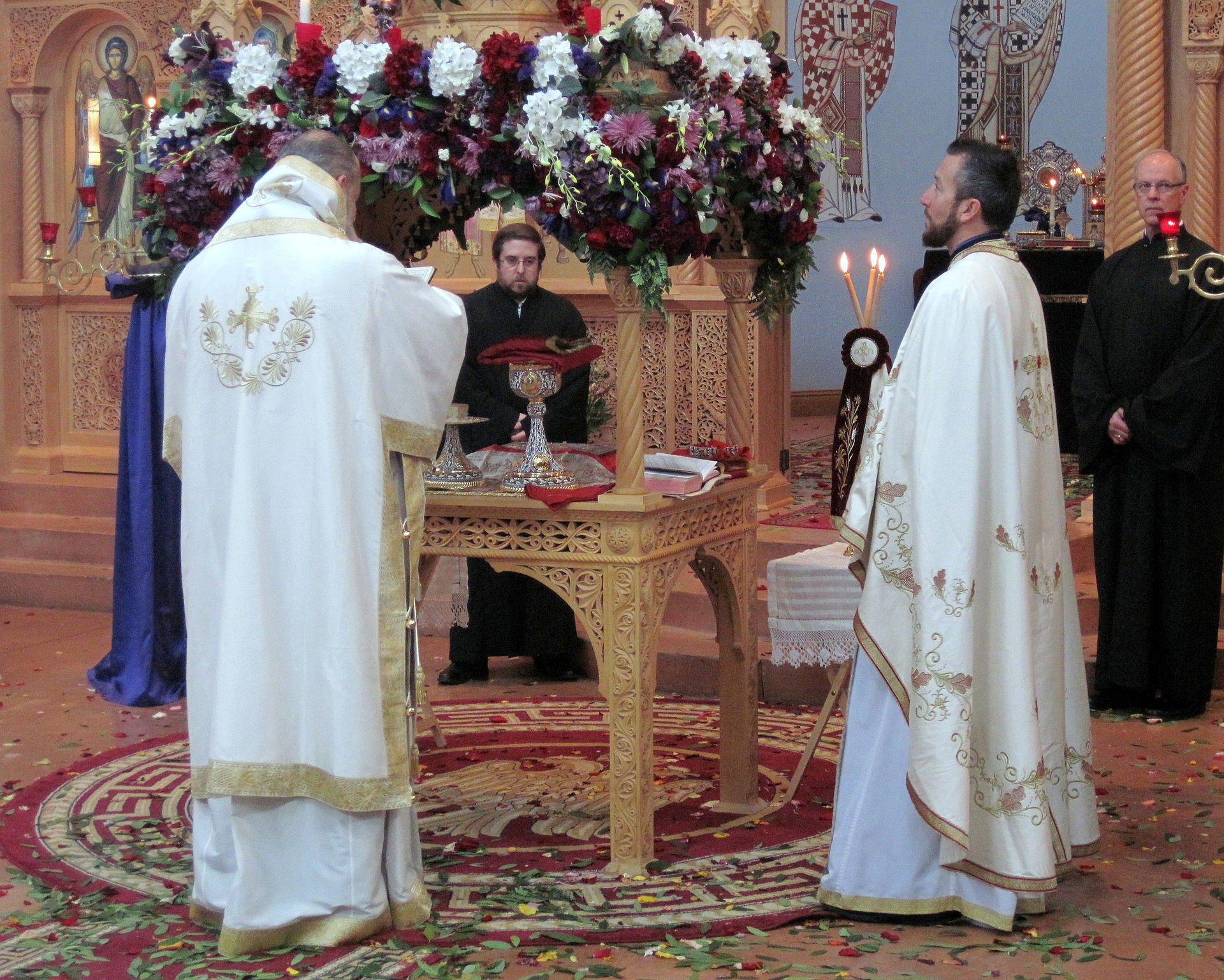 Divine Liturgy of Holy Saturday in a Greek Orthodox church in the United States 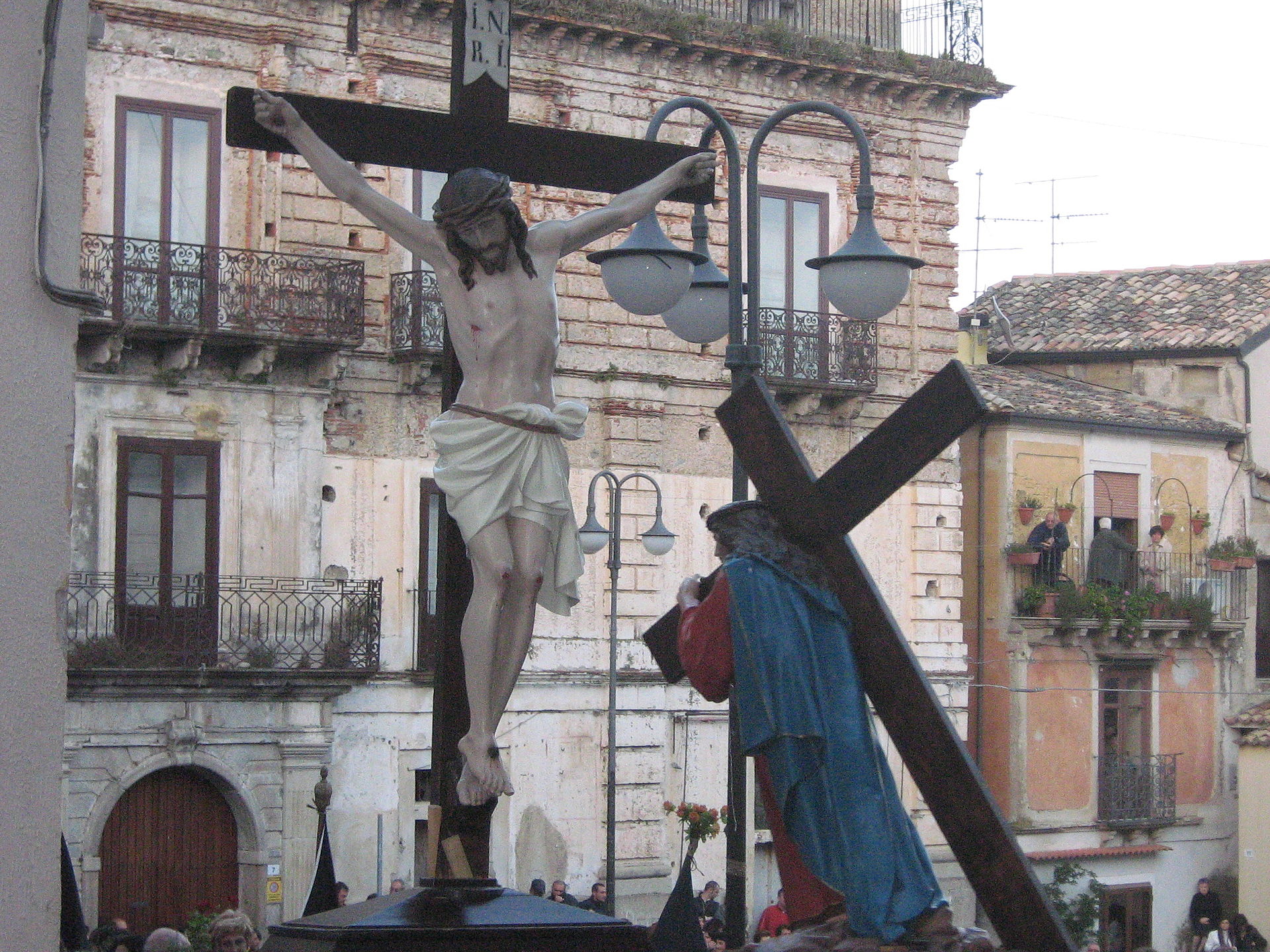 Holy Saturday in Caulonia, Italy Holy Saturday is the day between the crucifixion of Jesus and his resurrection. As the Sabbath day, the Gospel accounts all note that Jesus was hurriedly buried in a cave tomb after his crucifixion, with the intent to finish proper embalming and burial ceremonies on Sunday, after the Sabbath had ended, as the Sabbath day prohibitions would have prevented observant Jews from completing a proper burial. In the Catholic tradition after the Good Friday service, which represents the burial of Jesus, until the Easter Vigil on Saturday night, no mass takes place whatsoever on Holy Saturday. The celebration of the Easter Vigil liturgically belongs to Easter Sunday. On Holy Saturday, the Church waits at the Lord's tomb, in prayer and fasting, meditating on his Passion and Death and on his Descent into Hell and awaiting his Resurrection. The Church abstains from the Sacrifice of the Mass, with the sacred table left bare, until after the solemn Vigil, that is, the anticipation by night of the Resurrection, when the time comes for paschal joys, the abundance of which overflows to occupy fifty days. Holy Communion may only be given on this day as Viaticum.[52] In some Anglican churches, including the Episcopal Church in the United States, there is provision for a simple liturgy of the word with readings commemorating the burial of Christ.[citation needed] The doors of the empty tabernacle of the main altar are left open, to symbolise that Jesus Christ is gone. The lamp or candle usually situated next to the tabernacle denoting the presence of Christ is blown out.[53] Main article: Easter Vigil  A Lutheran deacon holding the Paschal candle during the Easter Vigil In the Catholic, Anglican, Lutheran, Methodist, and Presbyterian traditions, the Easter Vigil, one of the longest and most solemn of liturgical liturgies, lasts up to three or four hours, consists of four parts:[12][54] The Service of Light The Liturgy of the Word The Liturgy of Baptism: The sacraments of Baptism and Confirmation for new members of the Church and the Renewal of Baptismal Promises by the entire congregation. Holy Eucharist The Liturgy begins after sundown on Holy Saturday as the crowd gathers inside the unlit church. In the darkness (often in a side chapel of the church building or, preferably, outside the church), a new fire is kindled and blessed by the priest. This new fire symbolizes the light of salvation and hope that God brought into the world through Christ's Resurrection, dispelling the darkness of sin and death. From this fire is lit the Paschal candle, symbolizing the Light of Christ. This Paschal candle will be used throughout the Eastertide, remaining in the sanctuary of the Church or near the lectern, and is kept in the baptistry throughout the liturgical year so that in the celebrations of baptisms the candles of the baptized may be lit from the candle.[55] 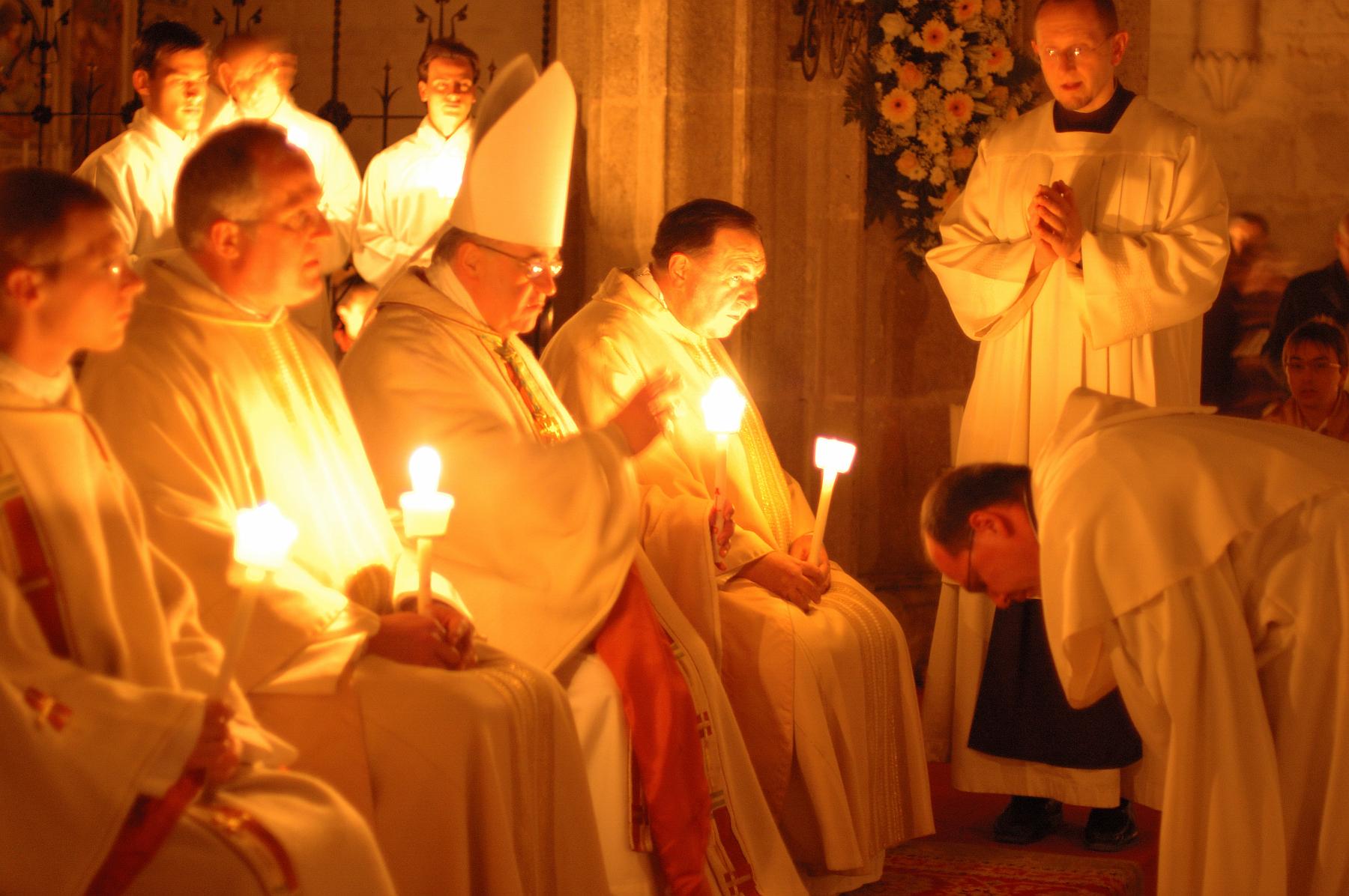 Candles lit for the Easter Vigil at Heiligenkreuz Abbey in Austria The candles of those present are lit from the Paschal candle. As this symbolic "light of Christ" spreads throughout those gathered, the darkness is decreased. A deacon, or the priest if there is no deacon, carries the Paschal Candle at the head of the entrance procession and, at three points, stops and chants the proclamation "The Light of Christ" (until Easter 2011, the official English text was "Christ our Light"), to which the people respond "Thanks be to God". Once the procession concludes with the singing of the third proclamation, the lights throughout the church are lit, except for the altar candles. Then the deacon or a cantor chants the Exultet, also called the "Easter Proclamation". After that, the people extinguish their candles and sit down for the Liturgy of the Word.[56] The Liturgy of the Word includes nine readings, seven (or at least three) from the Old Testament, followed by two from the New (an Epistle and a Gospel). The reading of the crossing of the Red Sea (Ex 14) must never be omitted. Each Old Testament reading is followed by a psalm or canticle (such as Exodus 15:1–18 and a prayer relating what has been read to the Mystery of Christ.[56] After the Old Testament readings conclude, the Gloria in excelsis Deo, which has been suspended during Lent, is intoned and bells are rung. A reading from the Epistle to the Romans is proclaimed. The Alleluia is sung for the first time since the beginning of Lent. The Gospel of the Resurrection then follows, together with the Responsorial psalmody.[56] After the conclusion of the Liturgy of the Word, the water of the baptismal font is blessed and any catechumens or candidates for full communion are initiated into the church, by baptism or confirmation. After the celebration of these sacraments of initiation, the congregation renews their baptismal vows and receive the sprinkling of baptismal water. The general intercessions follow.[56] After the Liturgy of Baptism, the Liturgy of the Eucharist continues as usual. This is the first Mass of Easter Day. During the Eucharist, the newly baptised receive Holy Communion for the first time. According to the rubrics of the Missal, the Easter vigil "ends before the dawn on the Sunday".[57] |
聖土曜日(黒い土曜日) 詳細は「聖土曜日」を参照  米国のギリシャ正教会における聖土曜日の神聖な典礼  イタリアのコーロニアにおける聖土曜日 聖土曜日は、イエスの磔刑と復活の間の日である。安息日であるため、福音書はすべて、安息日が終わった後の日曜日に適切なエンバーミングと埋葬の儀式を終 えるつもりで、イエスが磔刑後に急いで洞窟の墓に埋葬されたと伝えている。安息日の禁止事項により、敬虔なユダヤ人は適切な埋葬を完了することができな かったであろうから。 カトリックの伝統では、イエスの埋葬を象徴する聖金曜日のミサの後、土曜日の夜の復活祭前夜祭まで、聖土曜日にはミサは一切行われない。復活祭前夜祭の祝典は典礼上、復活祭の日曜日に属する。 聖土曜日には、教会は主の墓の前で祈りと断食を捧げながら、主の受難と死、そして地獄への降下について思いを巡らせ、復活を待つ。教会は、復活祭の喜びの 時が訪れ、その喜びが50日間続くという復活祭の予祝である厳粛な復活祭の徹夜祭が終わるまで、聖餐式を控え、聖餐卓を空のままにしておく。この日だけ は、聖餐式が旅立ちの準備として行われる。[52] 米国聖公会を含むいくつかの聖公会では、キリストの埋葬を記念する朗読を含む簡素な聖書朗読の儀式が定められている。 主祭壇の空の聖櫃の扉は開け放たれ、イエス・キリストが去ったことを象徴する。通常聖櫃の隣に置かれキリストの存在を示す燭台のランプまたは蝋燭は消される。 詳細は「イースター・ヴィジル」を参照  イースター・ヴィジルで復活祭の蝋燭を持つルーテル派の助祭 カトリック、聖公会、ルーテル派、メソジスト、長老派の伝統では、典礼の中で最も長く厳粛なもののひとつであるイースター・ヴィジルは、3時間から4時間続き、4つの部分から構成される。 光の奉仕 ことばの典礼 洗礼の儀式:教会の新会員のための洗礼と堅信の秘跡、および全信徒による洗礼の約束の更新。 聖餐式 この儀式は、聖土曜日の日没後に、照明のない教会内に群衆が集まった後に始まる。暗闇の中で(多くの場合、教会建物の側廊にある礼拝堂、または望ましくは 教会の外で)、司祭が新しい火を灯し、祝福する。この新しい火は、キリストの復活によって神がこの世にもたらした罪と死の闇を払う救いと希望の光を象徴す る。この火から復活祭のろうそくに火が灯され、キリストの光を象徴する。この復活祭のろうそくは、イースターの期間中、教会の聖域内または聖書台の近くに 置かれ、典礼暦の期間中、洗礼式で洗礼を受ける人のろうそくがこのろうそくから灯されるように、洗礼堂に保管される。[55]  オーストリアのハイリゲンクロイツ修道院で復活祭の徹夜祭のために灯されたろうそく 参列者のろうそくは、復活祭のろうそくから灯される。この象徴的な「キリストの光」が参列者全体に広がることで、暗闇が薄らいでいく。助祭、または助祭が いない場合は司祭が、入場行進の先頭で復活祭の蝋燭を掲げ、3か所で立ち止まり、「キリストの光」という宣言を唱える(2011年の復活祭までは、公式の 英語のテキストは「キリストは我らの光」であった)。これに対して人々は「神に感謝」と応える。行列が3回目の宣言を歌って終了すると、祭壇の蝋燭を除い て、教会内の照明が点灯される。その後、助祭または聖歌隊が「復活の宣言」とも呼ばれる「エクスルテ」を歌う。その後、人々は蝋燭の火を消して、み言葉の 典礼のために着席する。 「ことばの典礼」には9つの朗読があり、そのうち7つ(少なくとも3つ)は旧約聖書から、それに新約聖書から2つ(使徒書簡と福音書)が続く。紅海を渡る 場面(出エジプト記14章)の朗読は、決して省略してはならない。旧約聖書の朗読はそれぞれ、詩篇または賛歌(出エジプト記15:1-18など)が続き、 朗読された内容がキリストの神秘と関連付けられた祈りが唱えられる。 旧約聖書の朗読が終わると、四旬節の間中断されていた「天にいます我らの父よ」が歌われ、鐘が鳴らされる。ローマ人への手紙の朗読が宣言される。四旬節が始まって以来初めて、アレルヤが歌われる。その後、応答唱文とともに復活の福音が朗読される。 ことばの典礼が終了すると、洗礼盤の水が祝福され、洗礼志願者や完全な交わりの候補者は洗礼または堅信によって教会に受け入れられる。これらの入信の秘跡の式典の後、会衆は洗礼の誓いを新たにし、洗礼の水を振りかける。その後、一般の執り成しの祈りが続く。 洗礼の典礼の後、通常通り聖餐の典礼が続く。これは復活祭の日の最初のミサである。聖餐の間、新たに洗礼を受けた者は初めて聖体拝領を受ける。ミサ典書の規定によると、復活祭の徹夜祭は「日曜日の夜明け前に終わる」ことになっている。[57] |
| Easter Day Main article: Easter 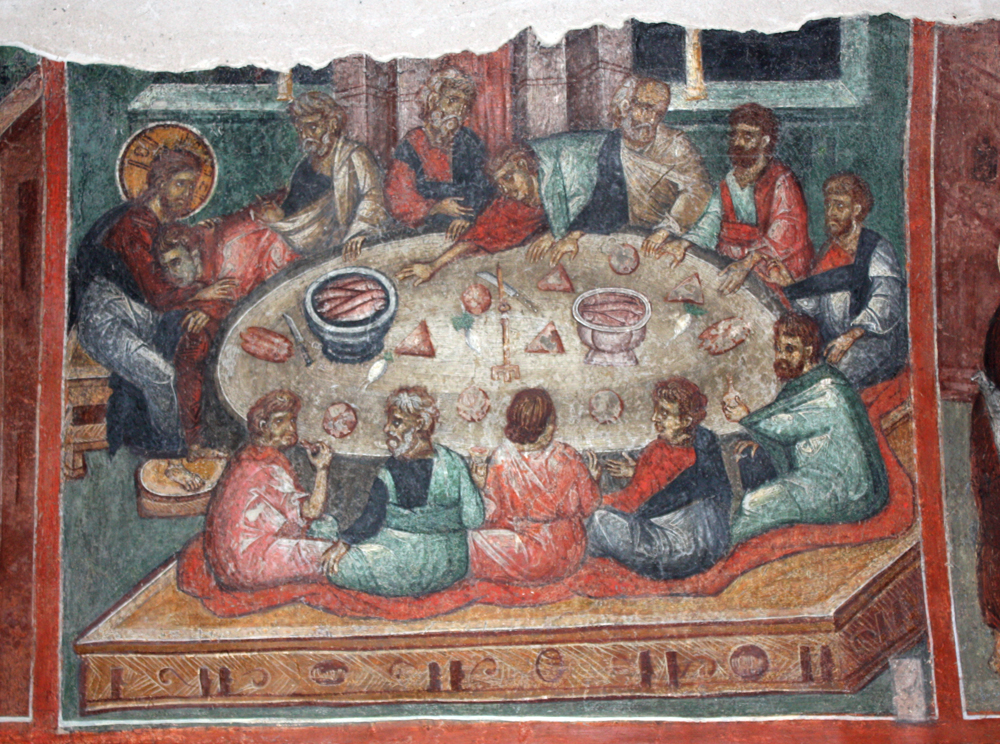 The Last Supper celebrated by Jesus and his disciples. The early Christians, too, would have celebrated this meal to commemorate Jesus's death and subsequent resurrection. Easter Day (or Easter Sunday), which immediately follows Holy Week and begins with the Easter Vigil, is the great feast day and apogee of the Christian liturgical year: on this day the Resurrection of Jesus Christ is celebrated. It is the first day of the new season of the Great Fifty Days, or Eastertide, which runs from Easter Day to Pentecost Sunday. The Resurrection of Christ on Easter Day is the main reason why Christians keep every Sunday as the primary day of religious observance.[citation needed] |
復活祭の日 詳細は「復活祭」を参照  イエスと弟子たちが祝った最後の晩餐。初期のキリスト教徒たちも、イエスの死と復活を記念してこの食事を祝ったであろう。 復活祭の日(または復活祭の日曜日)は、聖週間直後に復活徹夜祭で始まる、キリスト教の典礼暦における最も重要な祝日であり、最高潮に達する日である。こ の日、イエス・キリストの復活が祝われる。復活祭の日から聖霊降臨日曜日までの「大五旬節」と呼ばれる新シーズンの初日でもある。キリスト教徒が毎週日曜 日を宗教的儀式の主要な日として守る主な理由は、復活祭におけるキリストの復活である。 |
| Plenary indulgence In the Roman Catholic Church, plenary indulgence is granted once a day by the 1999 Enchiridion Indulgentiarum, in the following cases:[58] Adoration of the Blessed Sacrament for at least one half hour; The pious exercise of the Way of the Cross; Recitation of the Marian Rosary or of the hymn Akathistos, in church or an oratory; or in a family, a religious community, or a sodality of the faithful or, in general, when several of the faithful are gathered for any good purpose; The devout reading or listening to the Sacred Scriptures for at least a half an hour. Holy Week observances |
完全免罪 ローマ・カトリック教会では、1999年の『免罪の小冊子』によって、以下のケースにおいて1日1回完全免罪が認められている。 少なくとも30分間の聖体の礼拝、 十字架の道行きの信心深い実践、 教会または礼拝堂でマリアのロザリオまたはアカテイスモの賛美歌を唱えること、または家庭、修道会、信者の団体、または一般的に、何らかの善き目的のために信者の数人が集まる場合、 少なくとも30分間、神聖な聖典を熱心に読むこと、または聞くこと。 聖週間の慣習 |
| https://en.wikipedia.org/wiki/Holy_Week |
El
Silencio Holy Wednesday Procession in Ronda, Spain
****
| Celebraciones En gran parte del mundo existen celebraciones asociadas a la Semana Santa, algunas de ellas de un enorme interés a nivel internacional. Asia Filipinas En Filipinas, siendo un país de mayoría católica y antigua colonia española, se celebra la Semana Santa, también conocida como Mahal na araw en tagalo. La celebración empieza con el Domingo de Ramos (o Linggo ng Palaspas, 'Domingo de Palmas') y termina con el Linggo ng Pagkabuhay ('Domingo de la resurrección').[7] 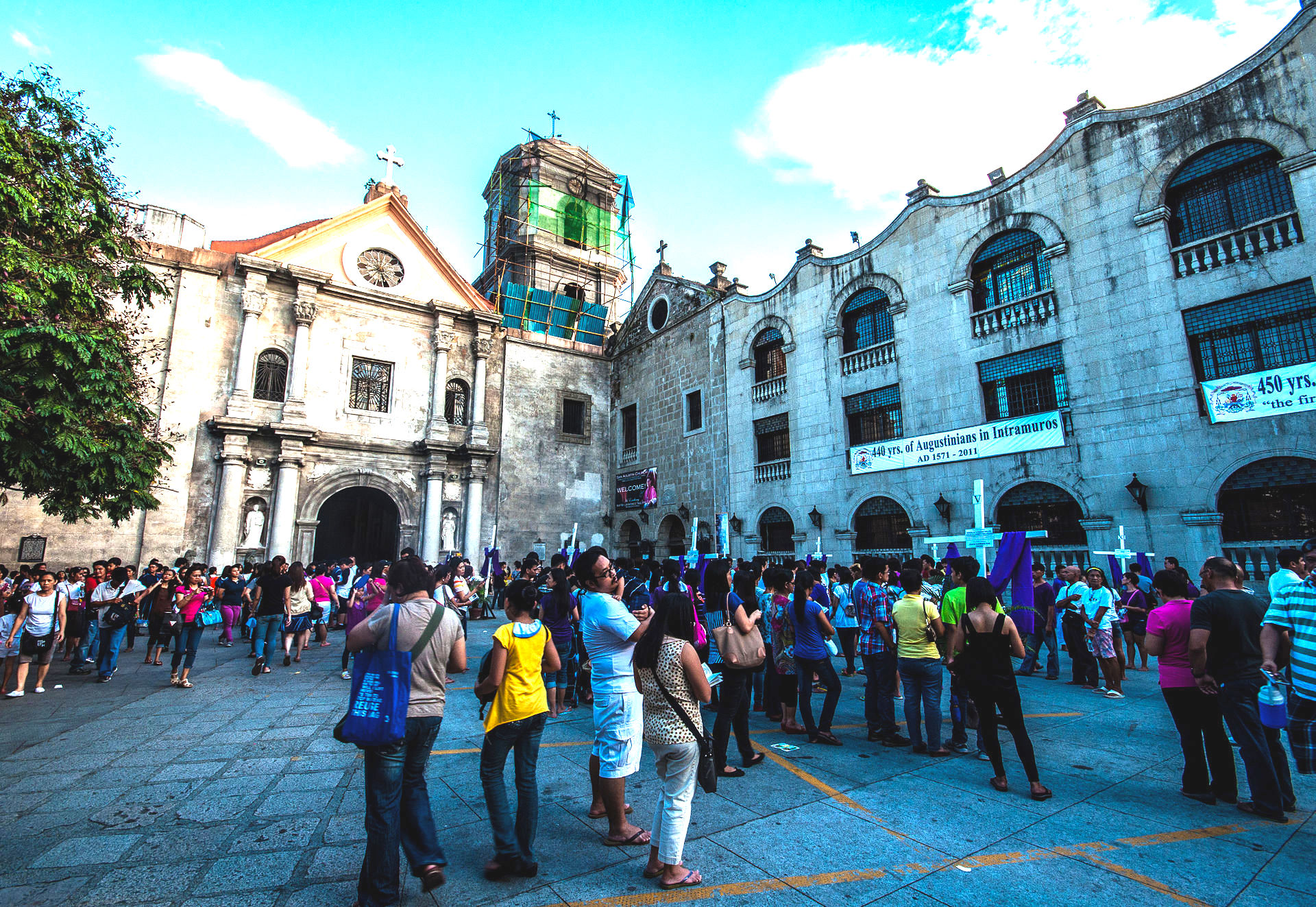 La Iglesia de San Agustín en Intramuros, Manila durante el Miyérkoles Santo de 2013 Días de la Semana Santa en Filipinas Domingo de Ramos/Linggo ng Palaspas Lunes Santo Martés Santo Miyérkoles Santo (Miércoles santo) Huwebes Santo (Jueves santo) Biyernes Santo (Viernes Santo) Sábado de Gloria Linggo ng Pagkabuhay/Pasko ng Pagkabuhay (Domingo de la Resurrección) La Visita Iglesia es una tradición católica en la que los católicos visitan 7 diferentes iglesias entre el Huwebes Santo y el Biyernes Santo.[8] El Huwebes Santo indica el comienzo de los días no laborales, mientras que el Sábado de Gloria marca su fin. |
祝祭 世界の多くの地域でイースターにちなんだ祝祭が行われており、その中には国際的に大きな関心を集めているものもある。 アジア フィリピン カトリック教徒が多数を占め、かつてはスペインの植民地であったフィリピンでは、タガログ語でMahal na arawとも呼ばれる聖週間を祝う。この祝いは、パーム・サンデー(Linggo ng Palaspas、「棕櫚の日曜日」)に始まり、リンゴ・パグカブヘイ(Linggo ng Pagkabuhay、「復活の日曜日」)で終わる[7]。  2013年のミエルコレス・サント期間中、マニラのイントラムロスにある聖オーガスティン教会。 フィリピンの聖週間 パーム・サンデー(Palm Sunday/Linggo ng Palaspas 復活祭の月曜日 マルテス・サント ミエルコレス・サント(聖水曜日) 聖木曜日(Huwebes Santo) 聖金曜日 栄光の土曜日(Sábado de Gloria) 復活の日曜日(Linggo ng Pagkabuhay/Pasko ng Pagkabuhay) Visita Iglesiaはカトリックの伝統で、カトリック信者はHuwebes SantoとBiyernes Santoの間に7つの異なる教会を訪問する[8] Huwebes Santoは聖週間の始まりを示す。 フウェベス・サントは非労働日の始まりを意味し、栄光の土曜日はその終わりを意味する。 |
| Europa España Artículo principal: Semana Santa en España 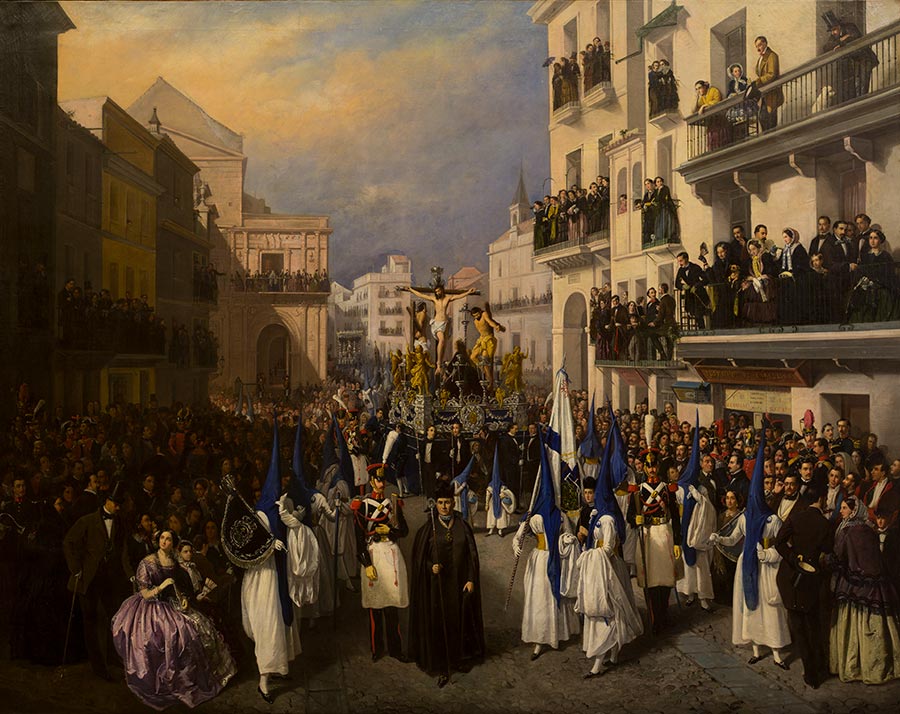 Procesión en Sevilla, obra de Manuel Cabral Aguado-Bejarano (1855), conservado en el Museo Nacional de Bellas Artes de La Habana. En España, son reconocidas de interés turístico internacional la Semana Santa de Palencia, Semana Santa de León, Semana Santa de Zamora, Semana Santa de Sevilla, Semana Santa de Granada, la Semana Santa en Málaga, la Semana Santa de Valladolid, de Cuenca, Zaragoza, Lorca, Córdoba, Medina del Campo, Viveiro, Toledo o Cartagena entre otras. Y son reconocidas de interés turístico nacional, la Semana Santa marinera de Valencia (2011), Semana Santa de Jerez de la Frontera (1993), la Pasión viviente de Castro Urdiales (2012), Los Picaos de San Vicente de la Sonriera (2005) y Semana Santa de Cáceres (2011) entre otras de igual titulación. Independientemente de la emoción que se vuelque en esta celebración, en todos los territorios españoles se conmemora la Pasión de Cristo 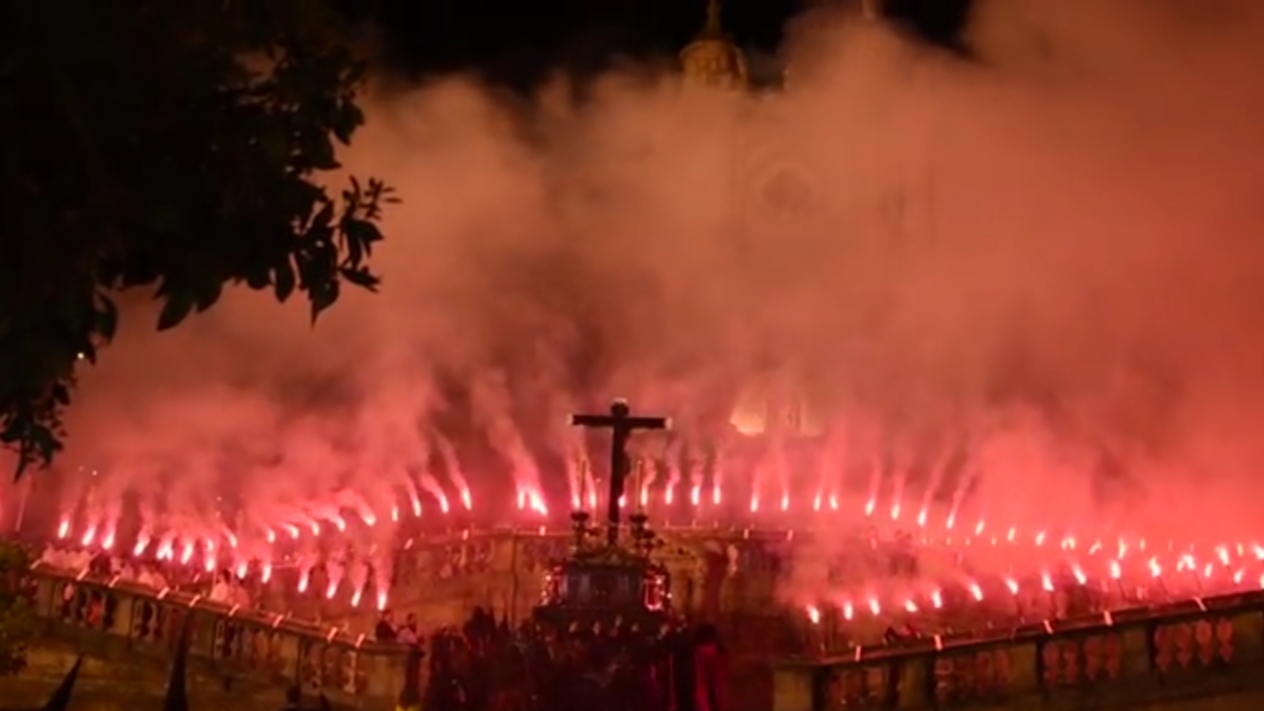 Semana Santa en Jerez de la Frontera. Italia En Italia la Semana Santa es muy sentida, principalmente en el sur, por la influencia aragonesa y luego española desde el siglo xiii. Se celebra la Semana Santa en más de 112 pueblos y ciudades, 83 solamente en Sicilia. |
ヨーロッパ スペイン 主な記事:スペインの聖週間  マヌエル・カブラル・アグアド=ベジャラーノの作品『セビリアの行列』(1855年)、ハバナ国立美術館に保存されている。 スペインでは、パレンシアのイースター・ウィーク、レオンのイースター・ウィーク、サモラのイースター・ウィーク、セビリアのイースター・ウィーク、グラ ナダのイースター・ウィーク、マラガのイースター・ウィーク、バリャドリッドのイースター・ウィーク、クエンカ、サラゴサ、ロルカ、コルドバ、メディナ・ デル・カンポ、ビベイロ、トレド、カルタヘナのイースター・ウィークなどが国際的な観光名所として認められている。バレンシアの復活祭週間(2011 年)、ヘレス・デ・ラ・フロンテーラの復活祭週間(1993年)、カストロ・ウルディアレスの生ける受難(2012年)、サン・ビセンテ・デ・ラ・ソンリ エーラのロス・ピカオス(2005年)、カセレスの復活祭週間(2011年)など、同じタイトルのものがある。キリストの受難は、この祝祭にどのような感 情が含まれるかは別として、スペイン全土で記念される。  ヘレス・デ・ラ・フロンテーラの聖週間。 イタリア イタリアでは、13世紀以降のアラゴン、そしてスペインの影響により、主に南部で聖週間が深く根付いている。復活祭は112以上の町や都市で祝われ、シチ リア島だけでも83の町や都市で祝われる。 |
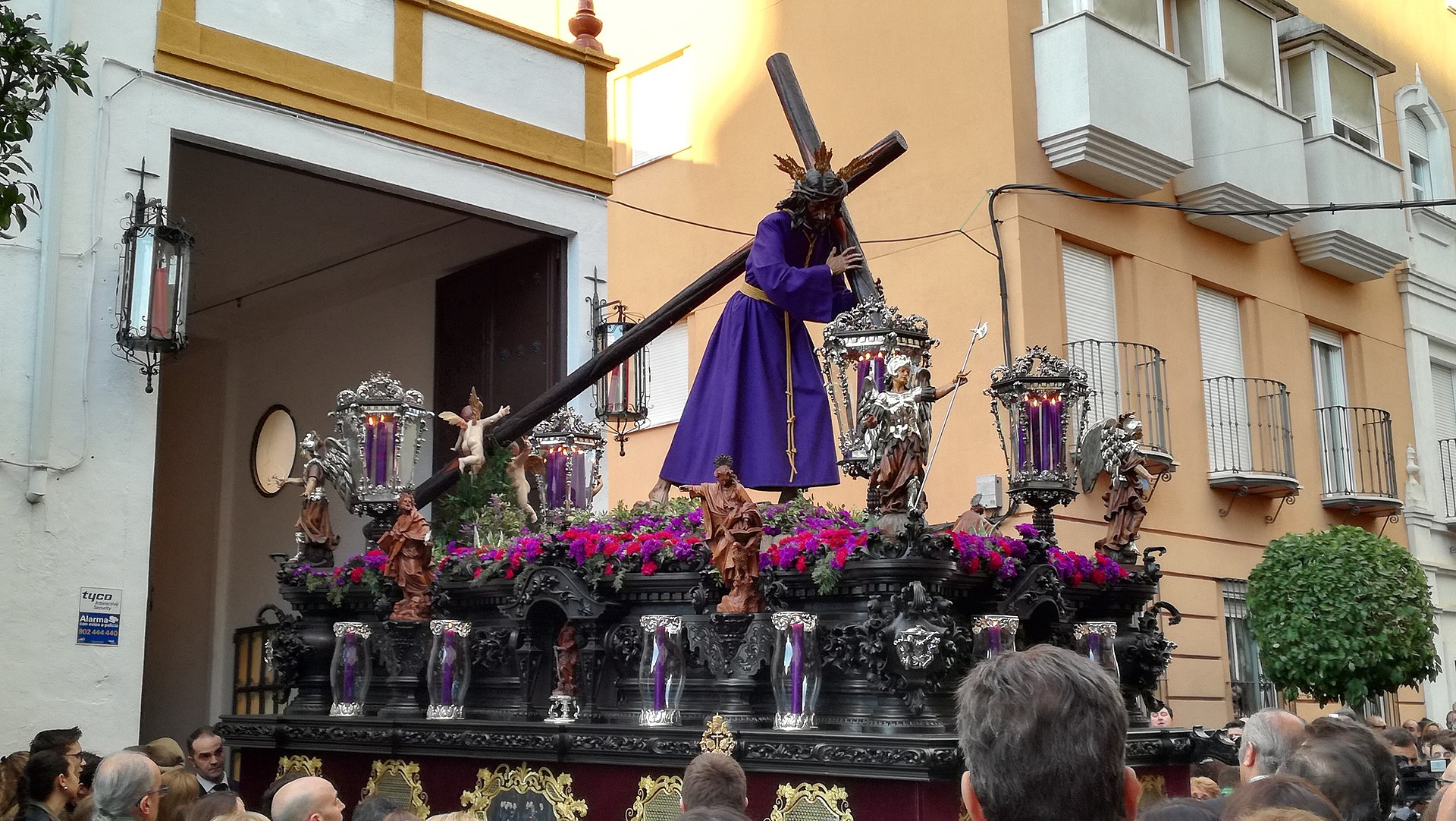 Jesús Nazareno saliendo de la capilla de «El Salvador». Cofradía de la Veracruz (Andújar, Jaén). Iberoamérica México En México es destacada como días santos, su celebración se lleva a cabo en varias entidades del país pero sobre todo destacan 2 principales, las cuales son conocidas por mayoría en algunas partes del mundo como lo son la representación de Taxco de Alarcón la segunda más importante del país y la primera y principalmente importante la cual es la Pasión de Cristo en Iztapalapa que se celebra año con año desde 1843 en esa demarcación de la Ciudad de México. Perú En Perú, destaca la Semana Santa en Ayacucho, evento religioso de mucho sincretismo, realizado ininterrumpidamente desde hace más de 150 años y con una duración inusual de diez días. También sobresale la Semana Santa en Lima, capital del país. Otras fiestas, que fueron declaradas como Patrimonio Cultural de la Nación, son en Pampacolca (2021), Chancay (2018), Catacaos (2018), Huambo (2012), Huancavelica (2013), entre otros.[9] Colombia En Colombia,[10] destacan la Semana Santa en Popayán, que hace parte de la Lista Representativa del Patrimonio Cultural Inmaterial de la Humanidad de la UNESCO; la Semana Santa en Santa Cruz de Mompox; la Semana Santa en Piedecuesta; la Semana Santa en Pamplona; la Semana Santa en Santa Fé de Antioquia; la Semana Santa en la Catedral de la Santísima Trinidad y San Antonio de Padua de Zipaquirá y en la Catedral de Sal en Zipaquirá; entre otras. Ley Emiliani (Ley 51 del 22 de diciembre de 1983) es aquella por la cual se logró mover los días festivos al próximo lunes de la fecha original. Estos puentes son utilizados por la mayoría de los colombianos para viajar, descansar y celebrar las fiestas patronales de su respectiva región.[11] Argentina Argentina conmemora Semana Santa desde el Domingo de Ramos hasta el Domingo de Resurrección. Sin embargo, únicamente el Jueves y Viernes Santo son días no laborables. Uruguay En Uruguay, debido a la secularización religiosa dada por la constitución de 1919. Al ciclo vacacional que corresponde a la Semana Santa se lo conoce oficialmente como «Semana de Turismo» estipulado por la ley de esa misma constitución que seculariza las fiestas religiosas, popularmente también se le da el nombre de Semana Criolla. Semana Santa y Semana de Pascua. Bolivia La Semana Santa en Bolivia incluye ayunos, peregrinaciones, procesiones y diferentes acciones que difieren de una región a otra. Brasil En Brasil, hay grupos de penitentes que salen a las calles rezando por los espíritus que sufren.[12] Guatemala 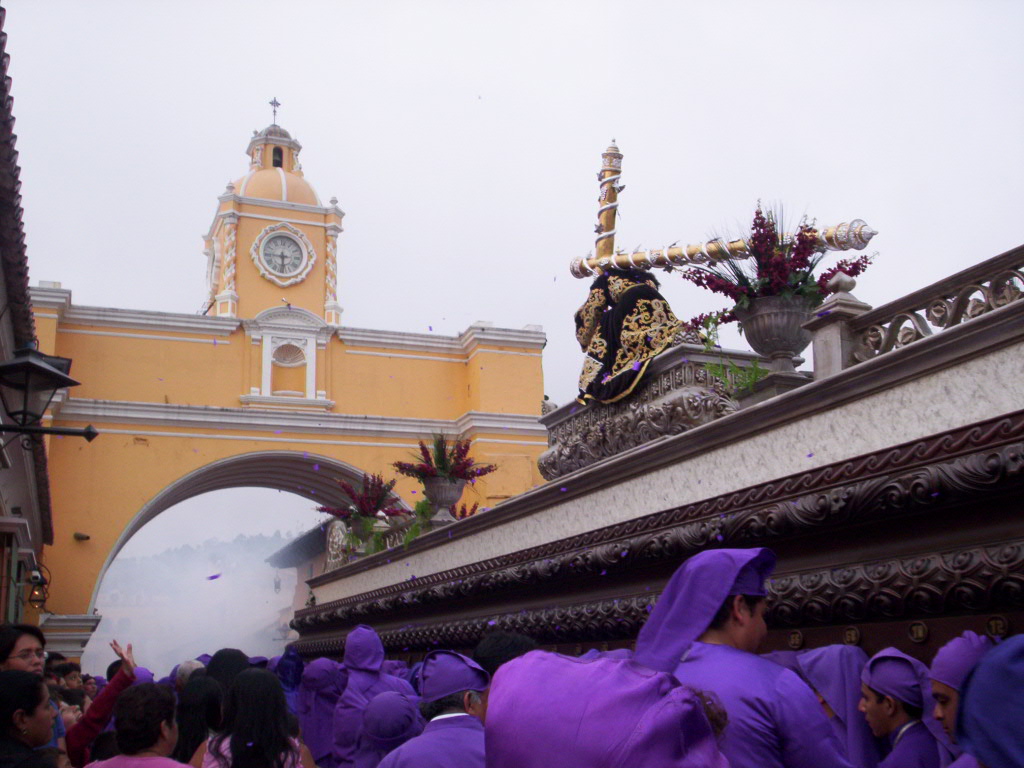 Procesión en la Ciudad de Antigua Guatemala. La Semana Santa en Guatemala, se celebra con la salida a la calle de manifestaciones de fe, llamadas procesiones, habitualmente organizadas por una hermandades, cofradías y asociaciones de pasión. En cada procesión de Semana Santa hay andas procesionales y pasos, que suelen ser imágenes religiosas de la Pasión de Cristo, o imágenes marianas, aunque hay excepciones como los pasos alegóricos o los de santos. También figuran los cucuruchos o cargadores con sus correspondientes insignias. En las procesiones participan devotos cargadores. Lo que lleva la hermandad es carretón que incluye horquillas, esquimales matracas, botiquín, incienso. La celebración fue declarada Patrimonio Cultural Inmaterial de la Humanidad por parte de la UNESCO[13] en noviembre de 2022. Nicaragua La Semana Santa en Nicaragua se celebra en todas las ciudades, siendo las festividades más destacadas son las de Granada y León. Honduras 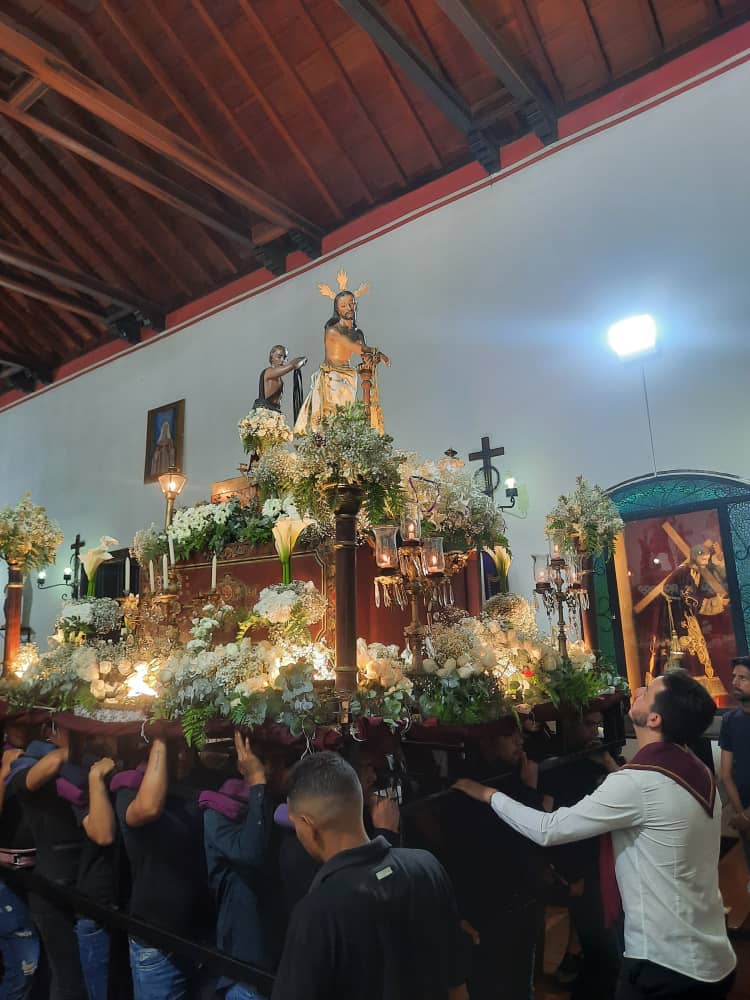 Procesión de Jesús atado a la columna en Baruta, Venezuela La Semana Santa en Honduras se celebra con una semana de vacaciones, que se hace a nivel Nacional. 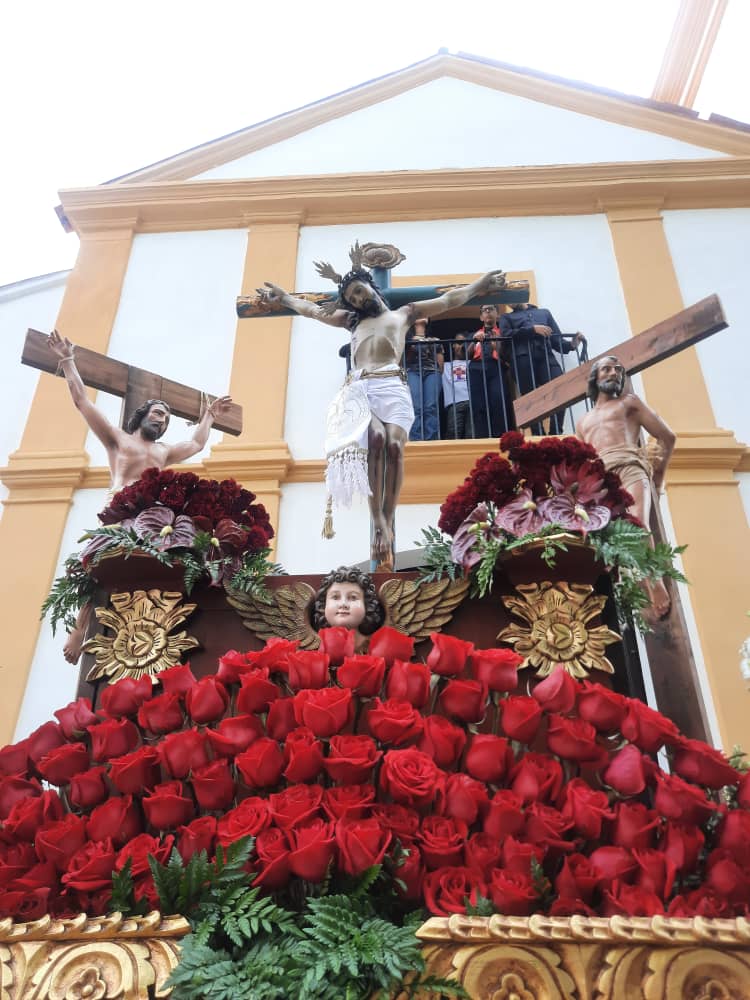 Procesión de la imagen del Santo Cristo crucificado de la parroquia Nuestra Señora del Rosario de Baruta, Venezuela Venezuela La Semana Santa corresponde a la siguiente luna llena después del equinoccio de primavera, empezando con el domingo y finaliza el sábado. Es tradición entre alguna gente no comer carne roja; solo pescado, chigüire y babo. Una actividad común en el país caribeño, durante el Domingo de Resurrección, es la quema de un monigote que representa a Judas Iscariote quien, según la mitología cristiana, traicionó a su maestro. Ecuador El día Viernes Santo se llevan a cabo las dos procesiones de Semana Santa más importantes del país: la de Jesús del Gran Poder en Quito, y la Procesión del Cristo del Consuelo en Guayaquil, que cada año acogen a miles de visitantes locales, nacionales y extranjeros. Asimismo, en la capital provincial de Santa Elena, tiene lugar el tradicional Baño de la Cruz el día Martes Santo, en el cual los pescadores de las localidades cercanas cargan en procesión una cruz de madera desde la iglesia principal hasta el balneario de Ballenita en donde sumergerán la cruz en el mar con el fin de les provea el sustento diario; el ritual finaliza con una eucaristía campal en el malecón del balneario. En otras ciudades del país también llevan a cabo sus propias procesiones comunitarias, los recorridos de las 7 iglesias, el rezo de las 7 palabras, el Viacrucis y la adoración de la cruz. Destacable también es la elaboración de la fanesca,que consiste en la elaboración de una sopa de 12 granos, legumbres, hortalizas y bacalao, siendo preparada en el país y en el departamento de Nariño en Colombia. La representación de los 12 granos se la atribuye a los apóstoles, y la del pescado, a Jesucristo. |
 エルサルバドル "の礼拝堂を後にするヘスス・ナサレノ。ベラクルス兄弟団(ハエン州アンドゥハル)。 イベロアメリカ メキシコ メキシコでは、キリストの受難は聖なる日として脚光を浴びており、その祝典は国内のいくつかの団体で行われているが、なかでもタクスコ・デ・アラルコンの ように国内で2番目に重要なものと、イスタパラパのように1843年から毎年メキシコ・シティの同地区で行われているキリストの受難の祝典の2つが際立っ ている。 ペルー ペルーでは、アヤクーチョの聖週間が際立っており、150年以上にわたって途切れることなく、10日間という異例の期間で開催されている、大きなシンクレ ティズムの宗教行事である。首都リマの聖週間もまた際立っている。国の文化遺産に指定された他の祭りは、パンパコルカ(2021年)、チャンカイ (2018年)、カタカオス(2018年)、フアンボ(2012年)、フアンカベリカ(2013年)などである[9]。 コロンビア コロンビアでは、ユネスコの人類無形文化遺産代表リストに登録されているポパヤンの聖週間、サンタ・クルス・デ・モンポックスの聖週間、ピエデクエスタの 聖週間、パンプローナの聖週間、サンタ・フェ・デ・アンチオキアの聖週間、ジパキアの三位一体聖堂とサン・アントニオ・デ・パドゥア聖堂、ジパキアの塩の 聖堂の聖週間などが目立つ[10]。 エミリアーニ法(1983年12月22日法律第51号)により、祝祭日は元の日付の次の月曜日に移動した。11]アルゼンチンでは、大部分のコロンビア人 が旅行や休養、各地域の守護聖人の日を祝うために祝日を利用している。 アルゼンチン アルゼンチンでは、パーム・サンデーからイースター・サンデーまでの聖週間を祝う。ただし、「聖木曜日」と「聖金曜日」だけは非営業日である。 ウルグアイ ウルグアイでは、1919年の憲法によって宗教的世俗化がもたらされたため、聖週間を祝う。聖週間に相当する祝日のサイクルは、宗教的な祝祭を世俗化する 同憲法の法律で規定された「観光週間」として公式に知られており、「セマナ・クリオーリャ(クレオール週間)」とも呼ばれ親しまれている。聖週間と復活祭 週間 ボリビア ボリビアの聖週間には、断食、巡礼、行列、地域によって異なるさまざまな行事が行われる。 ブラジル グアテマラでは聖週間がある。 グアテマラ  アンティグア・グアテマラ市での行列。 グアテマラの聖週間は、通常、兄弟団、友愛会、情熱協会によって組織される行列と呼ばれる街頭での信仰のデモンストレーションで祝われる。各聖週間行列に は、行列台とパソがあり、それらは通常、キリストの受難の宗教的イメージやマリア像であるが、寓意的なパソや聖人のパソなどの例外もある。また、ククルー チョ(担ぎ手)やカルガドール(担ぎ手)もあり、それぞれに対応する徽章が付けられている。行列には敬虔な担ぎ手も含まれる。兄弟団が運ぶのは、投石器、 エスキモーのガラガラ、救急箱、線香などを積んだワゴンだ。この祭典は2022年11月にユネスコによって人類無形文化遺産に登録された[13]。 ニカラグア ニカラグアのセマナ・サンタはすべての都市で祝われるが、最も著名な祭りはグラナダとレオンである。 ホンジュラス  ベネズエラのバルタにある柱に繋がれたイエスの行列。 ホンジュラスの聖週間は1週間の祝日で祝われ、全国レベルで行われる。  ベネズエラのバルタにあるヌエストラ・セニョーラ・デル・ロサリオ教区から十字架にかけられたキリスト像の行列。 ベネズエラ 聖週間は春分の日の次の満月に当たり、日曜日から土曜日に終わる。一部の人々の間では、赤身の肉を食べない習慣があり、魚、チグイレ、バボのみを食べる。 カリブ海沿岸の国では、イースターの日曜日に、キリスト教の神話によれば、主人を裏切ったイスカリオテのユダを象徴するミイラを焼くのが一般的な行事と なっている。 エクアドル 聖金曜日には、エクアドルで最も重要な2つの聖週間行列が行われる。キトではイエズス・デル・グラン・ポデルの行列が、グアヤキルではクリスト・デル・コ ンセーロの行列が行われ、毎年、国内外から何千人もの観光客が訪れる。同様に、州都サンタ・エレナでは、聖火曜日に伝統的な「十字架の浴場」が行われ、近 隣の町の漁師たちが木製の十字架を担いで大教会からビーチ・リゾートのバレニタまで行進し、日々の糧を得るために十字架を海に沈める。国内の他の都市で も、7つの教会、7つの言葉の暗唱、十字架の駅、十字架の礼拝など、独自の共同行進が行われる。 また、コロンビアのナリーニョ県で作られる、12穀物、野菜、タラのスープからなるファネスカの調理も注目に値する。12穀物は使徒たちに、魚はイエス・ キリストに由来する。 |
| Semana Santa de España Cofradía de Jesús Nazareno Gastronomía de Semana Santa Nuestra Señora de los Dolores Procesión Vía crucis Arma Christi Jesús de Nazaret en el cine |
スペインの聖週間 イエズス・ナサレノ兄弟団 イースター週間の美食 悲しみの聖母 行列 十字架の駅 アルマ・クリスティ 映画の中のナザレのイエス |
| https://es.wikipedia.org/wiki/Semana_Santa |
|
リ ンク
文 献
そ の他の情報
CC
Copyleft, CC, Mitzub'ixi Quq Chi'j, 1996-2099
☆
 ☆
☆